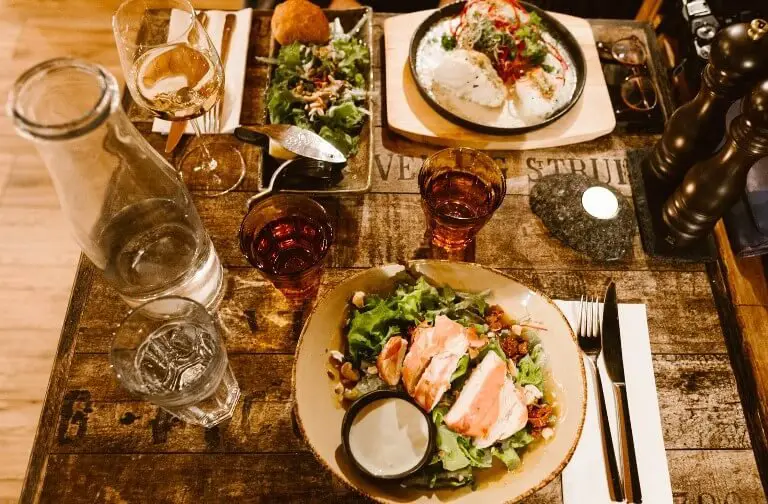Take Me to the Recipes!
Welcome to a journey through the diverse and intriguing world of Icelandic cuisine! This Nordic country may be small in size, but its culinary offerings are packed with unique flavors and traditions that reflect its history, culture, and pristine environment. From traditional dishes that have been passed down through generations to innovative modern twists, Icelandic cuisine is a treasure trove waiting to be explored.
One of the defining features of Icelandic cuisine is its focus on using fresh, natural, and locally-sourced ingredients. The harsh climate and rugged terrain of the country have shaped its culinary traditions, leading to a strong emphasis on seafood, lamb, dairy products, and foraged herbs and berries.
Join us as we delve into the world of Icelandic cuisine, from traditional favorites to innovative creations. Get ready to discover unique flavors and culinary techniques that will leave your taste buds wanting more!
Take Me to the Recipes!
Icelandic Cuisine – Key Takeaways:
- Icelandic cuisine reflects the country’s Nordic heritage and pristine environment.
- The focus on fresh, natural, and locally-sourced ingredients is a defining feature of Icelandic cuisine.
- Seafood, lamb, dairy products, and foraged herbs and berries are staples of Icelandic cuisine.
- Icelandic cuisine encompasses both traditional dishes and modern innovations.
- Exploring Icelandic cuisine is a culinary adventure you won’t forget!
Where is Iceland?

Iceland or “Ísland” as it is called in the native language is in Northern Europe, and a part of the Scandinavian union with Denmark, Norway, Faroe Islands, Finland and Sweden. The island is situated between the countries of Greenland, the Faroe Islands and Norway, South of the Arctic Circle.
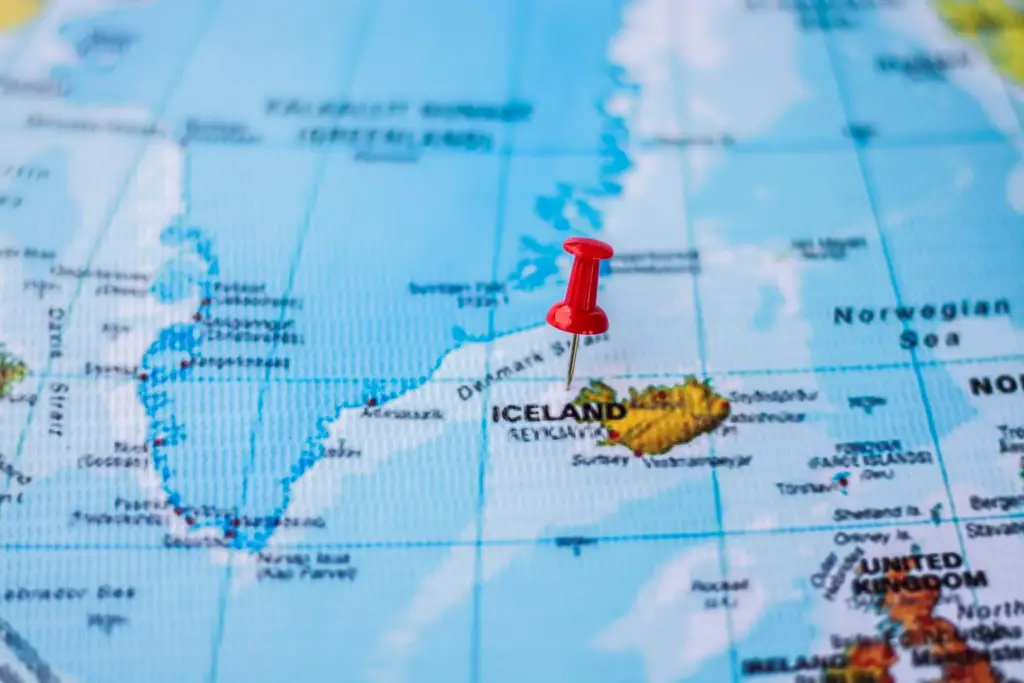
Index to the Contents
- Take Me to the Recipes!
- More Articles
- 10 Fascinating Facts about Iceland
- Iceland‘s History and the Effect It Has Had on the Cuisine
- How Iceland’s Climate and Geography Have Influenced Icelandic Cuisine
- Understanding the Essence of Icelandic Cuisine
- Icelandic Culinary Traditions
- Exploring Iceland’s Ingredients: The Flavors of Icelandic Cuisine
- Mastering Icelandic Cuisine Cooking Techniques
- Traditional Examples of Icelandic Food
- Exploring Icelandic Street Food
- The Most Popular Icelandic Recipes
- What are the Health Implications of Icelandic Cuisine?
- Iceland’s National Dish
- Icelandic Recipes you can try in your own kitchen
- Conclusion
- FAQ’s
You may also be interested in the Following Articles
- North and South American Cuisine – A Culinary Expedition
- Europe Cuisine: Savor the Continent’s Best Culinary Secrets!
- African Cuisine: Discover the Bold Flavors & Global Charm!
- Asian Cuisine Unlock its Secrets – Taste, Health & Global Influence!
Savor iconic Icelandic Food Recipes – Click on each tantalizing picture to open up the Recipe.

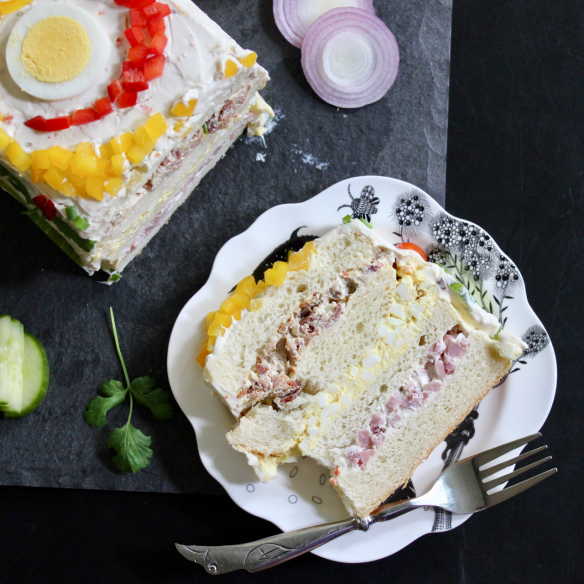
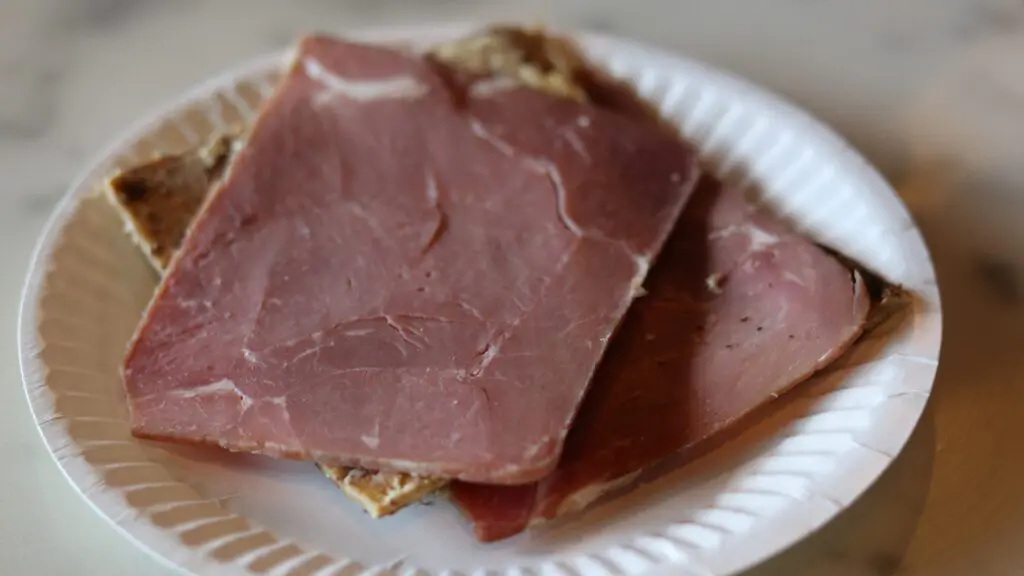

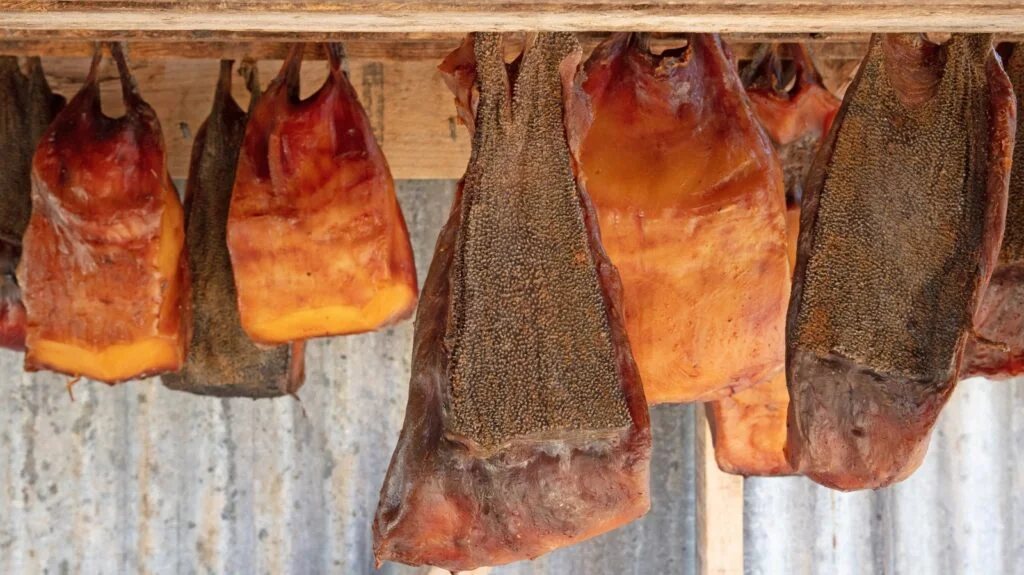

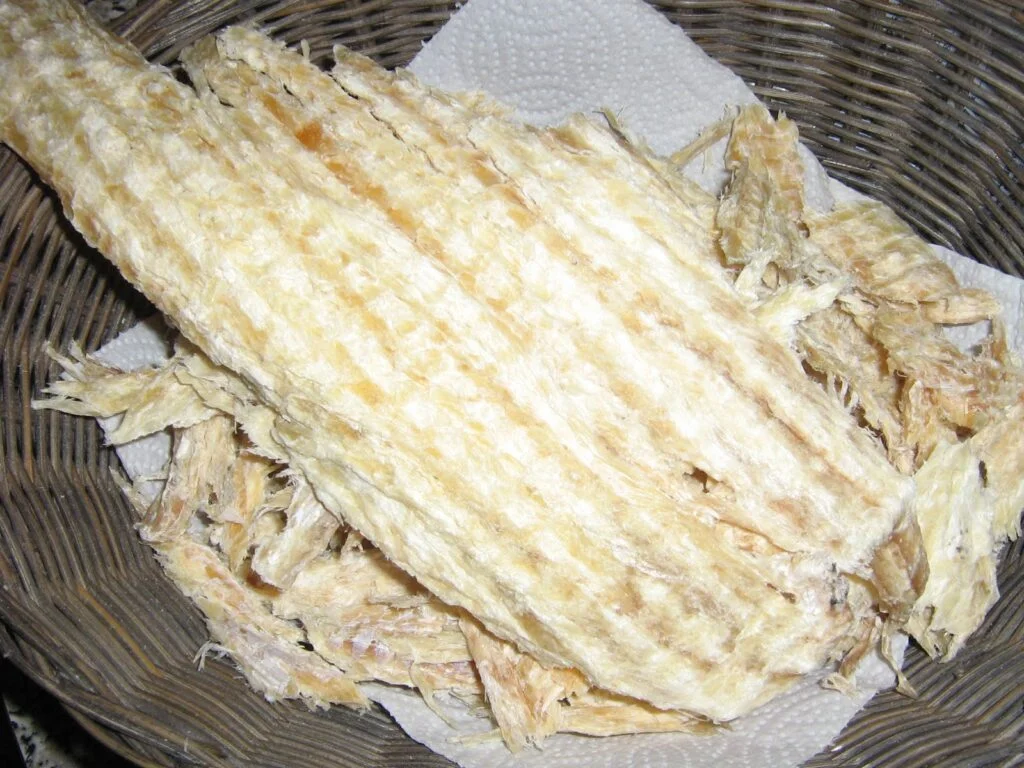
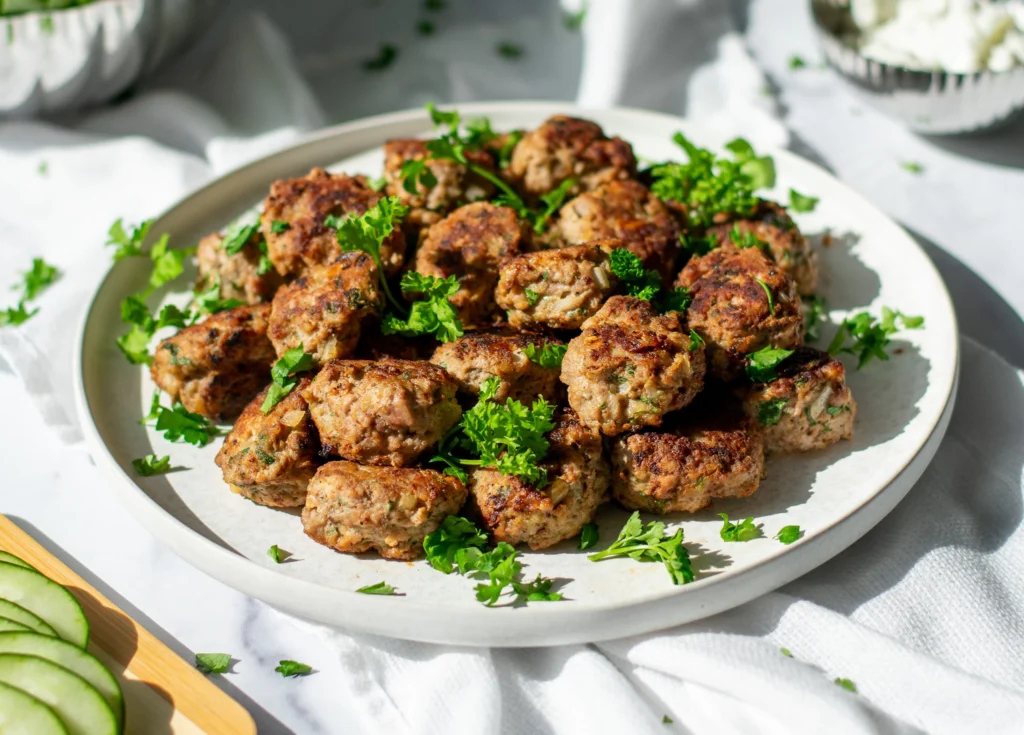
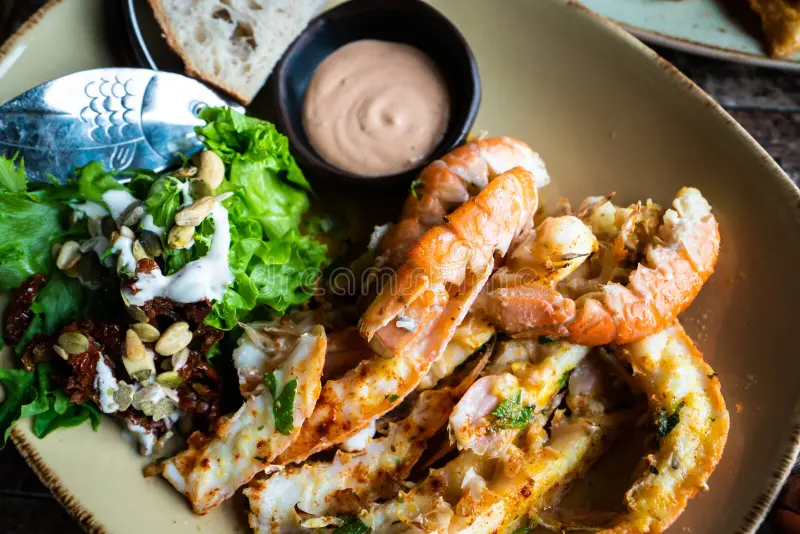

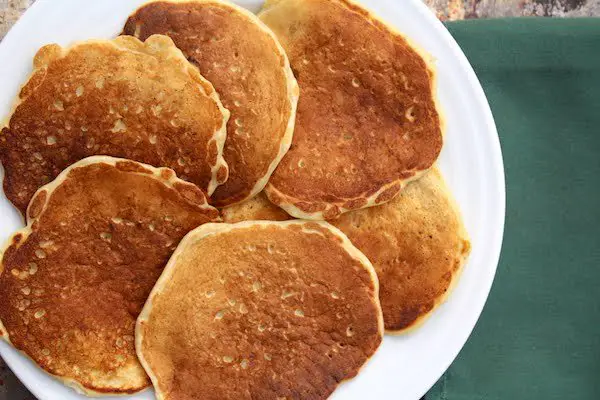

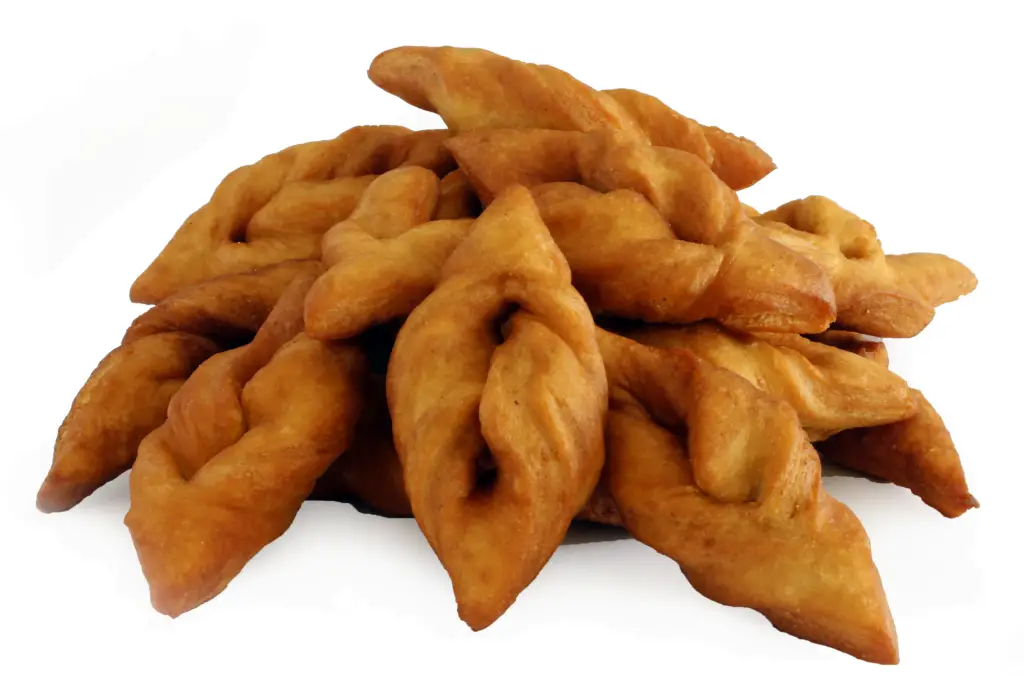
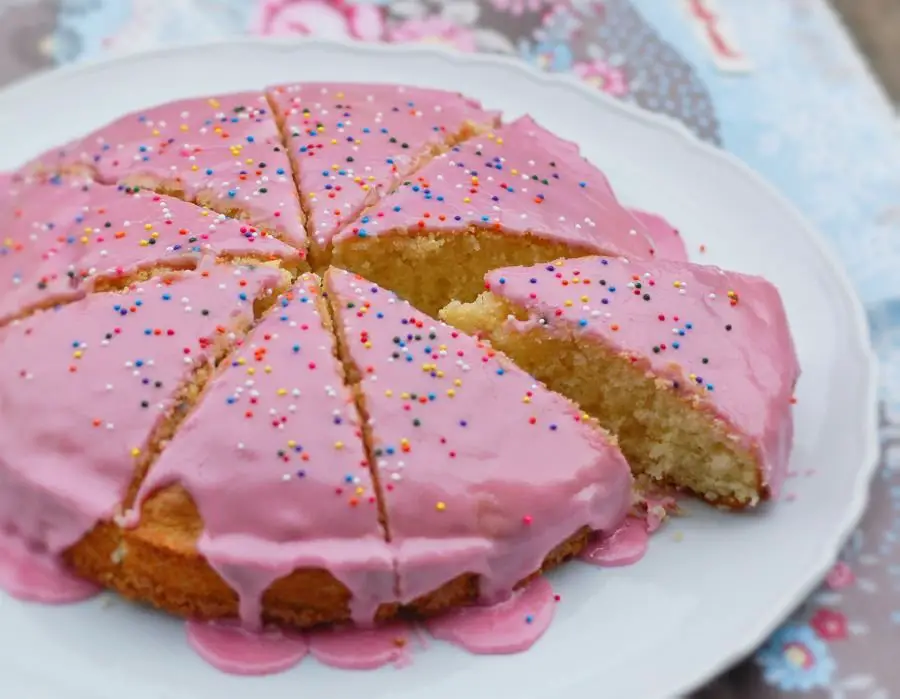



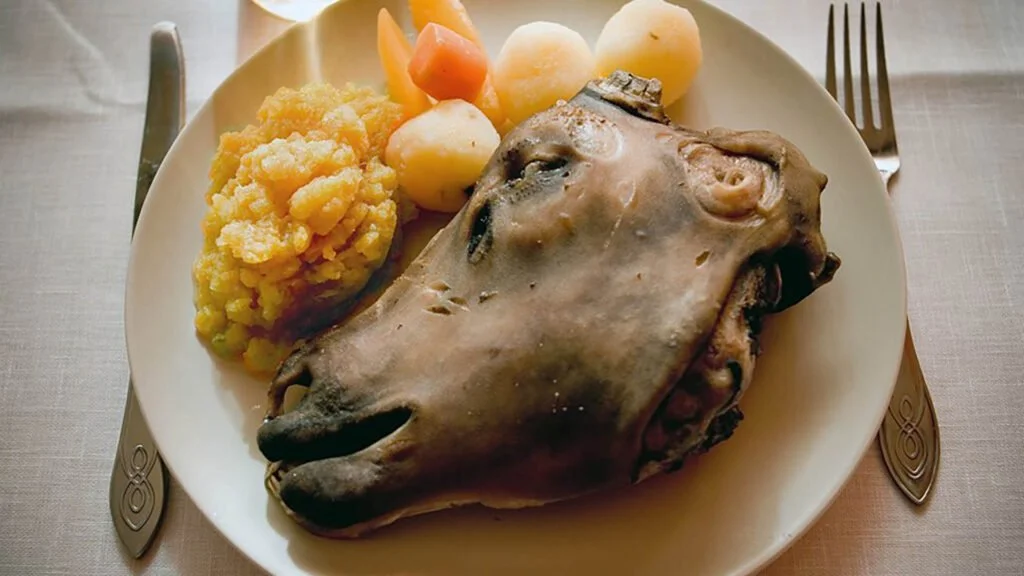
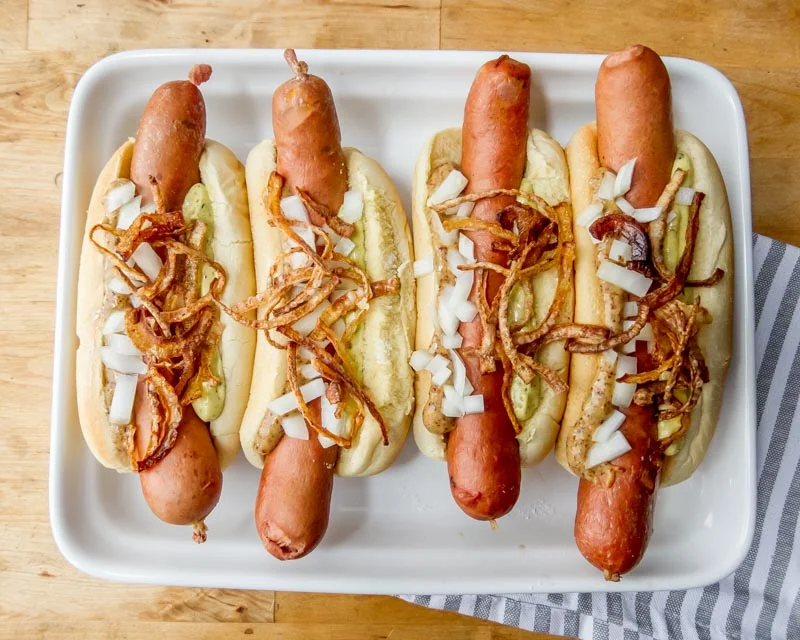
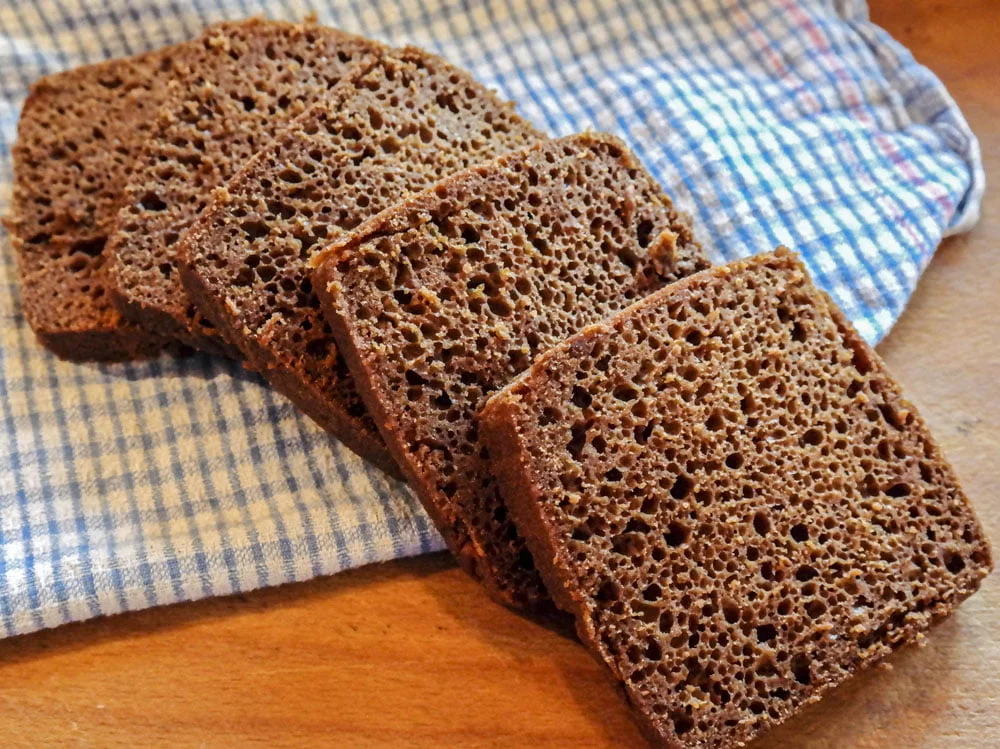

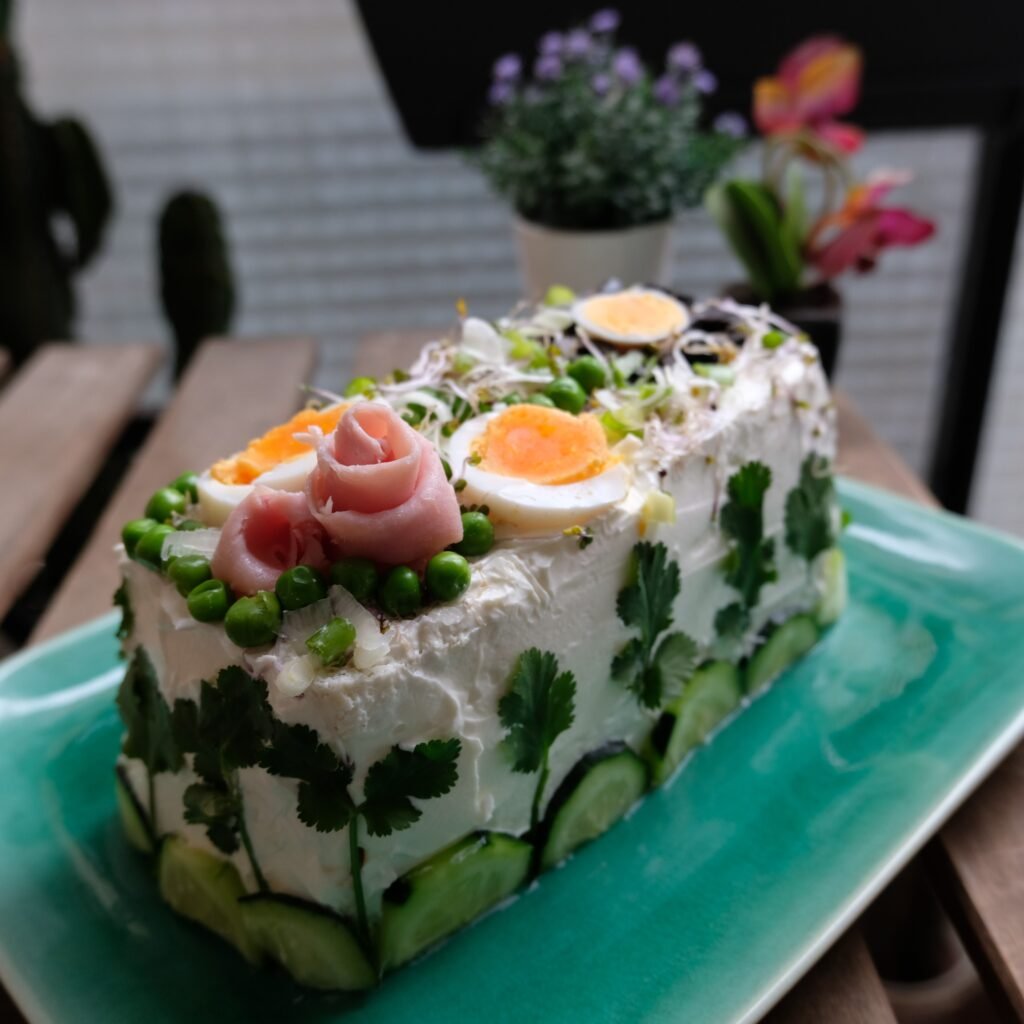
10 Fascinating Facts About Iceland: From Fire and Ice to Quirky Customs

Iceland, the Land of Fire and Ice, is a captivating island nation that never fails to surprise and intrigue visitors. Beyond its breathtaking landscapes of glaciers and volcanoes lie a wealth of unique customs, historical oddities, and fascinating facts.
Buckle up for a journey through 10 fascinating aspects of Icelandic life:
Volcanic Playground
Iceland boasts over 130 volcanoes, and around 30 are still considered active! This fiery landscape shapes the island, with geothermal energy heating homes and even powering greenhouses.
Land of the Midnight Sun

During the summer months, Iceland experiences the phenomenon of the midnight sun, where the sun never dips below the horizon. Imagine reading a book or going for a hike under the magical glow of the nightless sky!
The Vikings Left Their Mark
The first settlers in Iceland were Vikings who arrived in the late 8th and early 9th centuries. Their cultural influence is still evident in the Icelandic language and traditional Icelandic names.
No Mosquitoes (But Plenty of Midges)
Pack your bug spray for the tiny, pesky midges, but breathe easy – Iceland is one of the few places in the world completely free of mosquitoes, thanks to its cold climate and limited freshwater habitats.
A Nation of Bookworms
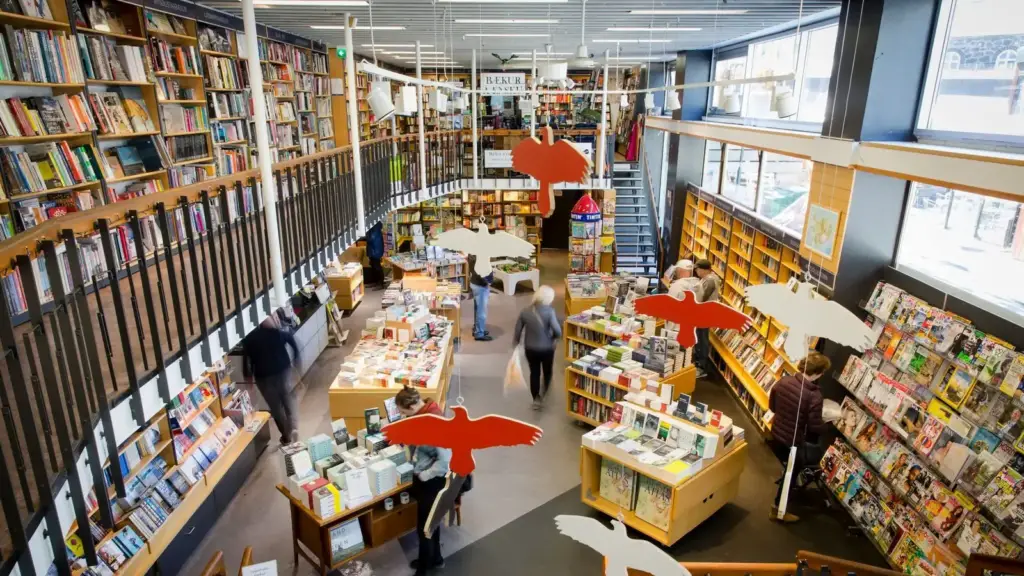
Icelanders hold the title of the most well-read nation in the world, with a high literacy rate and a thriving publishing industry. The Reykjavik International Literary Festival is a testament to their love of books.
The Hot Dog Reigns Supreme
Forget fancy restaurants – Icelanders have a deep-seated love for their humble hot dog, known as “pylsur.” Topped with unique condiments like remoulade and crispy fried onions, it’s a national street food treasure.
A President Who Once Worked as a Bartender

Iceland’s President, Guðni Th. Jóhannesson, held several interesting jobs before entering politics, including working as a historian, airline worker, and even a bartender.
Elf Sightings are Common
While not everyone claims to see them, a significant portion of Icelanders believe in the existence of elves and other hidden beings. The belief is deeply ingrained in Icelandic folklore and adds a touch of whimsy to the national character.
No Standing Army
Iceland is one of the few countries in the world without a standing army. It relies on NATO for its defense and maintains a small coast guard for maritime patrol and search and rescue operations.
Stripping is Illegal

Public nudity is legal in Iceland, but public striptease and strip clubs are strictly prohibited. This seemingly contradictory law reflects the nation’s unique approach to public decency and individual expression.
These are just a taste of the many fascinating aspects of Icelandic life. So, the next time you think of Iceland, remember that this island nation is more than just glaciers and volcanoes; it’s a land brimming with history, culture, and quirky customs waiting to be explored.
Iceland’s History and Its Effect on Cuisine

Iceland, a land of dramatic landscapes and captivating history, boasts a cuisine just as unique. Let’s embark on a delicious journey, exploring how each historical period has shaped the flavors and traditions on Icelandic plates.
Settling the Untamed Land (9th Century)
In the late 9th century, Viking explorers and enslaved people from Western Europe, primarily Norway and the British Isles, set foot on the uncharted territory of Iceland. These early settlers brought their culinary traditions, establishing the foundation for Icelandic food culture.
However, the harsh natural conditions, limited resources, and isolation of their new home greatly influenced their cuisine.
The Althing and the Sagas (10th Century)

By 930, Icelanders established the Althing, one of the world’s oldest parliaments, marking a significant step towards self-governance. Around the same time, Christianity arrived through Norwegian influence.
The Icelandic Sagas, chronicles of the nation’s history, documented the lives and, more importantly for our story, the culinary practices of the time. These sagas tell us that traditional Icelandic food centered around fish, lamb, and dairy products, laying the groundwork for the cuisine we know today.
The Age of the Sturlungs (13th Century)

The early 13th century brought internal conflicts that weakened Iceland, ultimately leading to its subjugation by Norway. This decline in independence impacted the availability and variety of food.
While traditional dishes like fish and lamb remained central to Icelandic cuisine, they faced challenges due to resource constraints.
Danish Rule and the Trade Monopoly (14th-19th Centuries)
From the 14th to the 19th centuries, Iceland fell under Danish rule. The Danish-Icelandic Trade Monopoly, while intended to benefit both parties, ultimately hampered the Icelandic economy and limited access to diverse ingredients.
Poverty and limited resources continued to be realities, forcing Icelanders to rely heavily on traditional foods. However, imported goods like grains and spices began to subtly influence culinary practices, adding a new layer to the story.
The Rise of Nationalism and Sovereignty (19th Century)
The 19th century witnessed the rise of nationalism in Iceland, leading to an independence movement. The Althing was restored in 1844, and Iceland finally gained full sovereignty after World War I.
This newfound independence fostered a strong sense of national identity and cultural pride, which also influenced food choices. Icelanders began to consciously embrace and celebrate their unique culinary heritage.
Modern Iceland: A Fusion of Tradition and Innovation (20th Century – Present)

Iceland declared itself a republic in 1944 and has since become a founding member of NATO and joined the United Nations. While globalization has introduced a wider variety of ingredients, traditional elements like fish, lamb, skyr (a type of yogurt), and hearty breads and potatoes remain central to Icelandic cuisine.
Today, innovative chefs are taking center stage, artfully blending local and international flavors to create a vibrant culinary scene.
Icelandic cuisine, much like the nation itself, is a captivating story of resilience, adaptation, and a deep connection to its roots. From the Viking settlers to the modern chefs, each chapter has left its mark on the unique flavors that continue to define Icelandic food culture.
References
- History of Iceland – Wikipedia
- Iceland | History, Maps, Flag, Population, Climate, & Facts
- Icelandic Food: The Ultimate Guide to Iceland Food Culture
- Icelandic Food & Cuisine – 15 Traditional Dishes to eat in Iceland
How Iceland’s Climate and Geography Influence Its Cuisine
Iceland, a land of breathtaking beauty and dramatic landscapes, boasts a cuisine that’s as unique as its environment. Let’s embark on a delicious journey to discover how Iceland’s location, climate, and geography have profoundly shaped its culinary traditions:
A Remote Island with a Rugged Charm

Iceland’s isolated position in the North Atlantic, far from mainland Europe, has carved a distinct path for its food culture. Historically, settlements were mainly concentrated near the coastline, restricting access to diverse ingredients.
The island’s volcanic activity has also played a significant role, shaped the rugged terrain and influenced the types of crops that can be grown in the volcanic soil. Additionally, the scarcity of trees, due to historical deforestation, meant firewood was scarce.
This led to the development of traditional cooking methods that relied on geothermal energy and turf ovens.
A Climate of Extremes

Iceland’s climate is characterized by extremes, presenting unique challenges for agriculture:
- Long, cold winters: Freezing temperatures and limited daylight restrict agricultural production, making it difficult to grow diverse crops.
- Short summers: The short growing seasons put pressure on crops to mature quickly, influencing the types of food that can be successfully cultivated.
- Frequent storms and strong winds: These harsh weather conditions make outdoor farming a constant battle against the elements.
A Regional Tapestry of Flavors
Despite the common challenges, Icelandic cuisine showcases regional variations influenced by local resources and historical factors:
- Coastal Regions: These regions are blessed with an abundance of seafood. Cod, haddock, and salmon are staples, while shellfish like langoustines and mussels thrive in the cold waters. Traditionally, wind-dried fish (harðfiskur) was a popular way to preserve the catch. Even eggs from seabirds like puffins and guillemots were historically consumed.
- Inland Regions: Here, sheep farming takes center stage. Icelandic lamb is renowned for its distinctive flavor and is a central element in many traditional dishes. Dairy products also flourish in these regions, with skyr, a thick yogurt, being a beloved staple. The harsh climate limits the variety of vegetables, but hardy options like potatoes and turnips are cultivated alongside wild berries like blueberries, crowberries, and bilberries.
- Geothermal Areas: Iceland’s unique geothermal energy has been harnessed to power greenhouses, allowing for the cultivation of tomatoes, cucumbers, and herbs. Additionally, some traditional dishes are still prepared using the natural heat of hot springs.
Modernity Meets Tradition
While respecting their heritage, modern Icelandic chefs are embracing innovations and trends:
- Local and Sustainable: An emphasis is placed on using high-quality, locally sourced ingredients. This focus on freshness and sustainability is evident in many Icelandic restaurants.
- Seafood Expertise: Many restaurants specialize in seafood dishes, showcasing the bounty of the surrounding waters with innovative culinary techniques.
- Creative Cuisine: Chefs are constantly pushing boundaries, creating unique dishes that use fresh local ingredients in unexpected ways. This spirit of culinary adventure is captured in events like the Food and Fun Competition, where chefs compete to create the most innovative dishes using local fare.
- Evolving Palates: While traditional foods remain popular, Icelanders are now incorporating more vegetables into their diet, reflecting a shift towards a health-conscious approach to food.
Iceland’s cuisine is a captivating story of adaptation, resourcefulness, and a deep connection to its environment. From the historical preservation methods to modern culinary innovations, each chapter reflects the unique challenges and triumphs of this remarkable island nation.
References
- Icelandic Cuisine – Wikipedia
- Icelandic Food: 9 Must-Try Traditional Dishes of Iceland
- Exploring Icelandic Cuisine: What to Eat in Iceland
- 18 Interesting Facts about Iceland Food – World’s Facts
- Iceland Geography Facts and Country Profile
Understanding the Essence of Iceland’s Cuisine

Iceland stands apart from its Nordic counterparts, boasting unique flavors and traditions born from centuries of isolation and a relentless yet awe-inspiring environment.
A Symphony of Simplicity
Unlike the elaborate culinary traditions of other European nations, Icelandic cuisine embraces simplicity. Dishes often feature a few key ingredients, each allowed to shine in their natural state.
Freshly caught fish, free-range lamb raised on volcanic soil, and dairy products crafted from the milk of grass-fed cows – these are the cornerstones of Icelandic food, each bursting with the unadulterated taste of the land.
Preserving the Bounty: A Legacy of Resourcefulness
Iceland’s harsh climate and limited resources forced its inhabitants to develop ingenious methods of preserving food. Traditional techniques like salting, drying, and fermenting played a crucial role in ensuring year-round sustenance.
Dishes like harðfiskur (dried fish), sviðs (singed sheep’s head), and hangikjöt (smoked lamb) are testaments to this legacy of resourcefulness, offering a glimpse into the resilience of the Icelandic people.
The Geothermal Embrace: Cooking with Nature’s Power

Iceland’s volcanic activity isn’t just a geological marvel; it’s also deeply woven into the fabric of its cuisine. Geothermal energy has been harnessed for centuries, not just for heating homes but also for cooking.
Hot springs were used to boil food, and turf ovens, fueled by volcanic rock, became a staple in Icelandic kitchens. This unique connection between the land and its culinary practices adds another layer of intrigue to the story.
Beyond Tradition: Embracing Modernity
While respecting their heritage, modern Icelandic chefs are pushing boundaries and embracing innovative techniques. Locally sourced ingredients are still celebrated, but they are now combined with global influences, resulting in a fusion of tradition and contemporary flair.
Icelandic chefs are also leading the charge in sustainability, utilizing local, seasonal ingredients and minimizing waste.
A Taste of Iceland: A Journey for the Senses
Icelandic cuisine is an invitation to embark on a sensory adventure. The first bite of skyr, a thick and creamy yogurt, is a revelation. The smoky aroma of hangikjöt hanging in a traditional smokehouse is an experience in itself.
And the delicate flavor of fresh seafood, caught just off the coast, is a testament to the purity of the Icelandic environment.
Icelandic Culinary Traditions

The country’s unique culinary traditions, shaped by centuries of isolation and a harsh environment, offer a fascinating glimpse into the rich history and resilience of the Icelandic people.
Rooted in Simplicity and Preservation
Unlike its European counterparts, Icelandic cuisine embraces a philosophy of less is more. Dishes often feature a limited number of ingredients, each allowed to shine in their natural state. Freshly caught fish, free-range lamb raised on volcanic soil, and dairy products crafted from the milk of grass-fed cows are the cornerstones of many traditional meals.
This simplicity reflects the resourcefulness of the Icelandic people, who learned to make the most of what their environment offered.
Preservation techniques played a crucial role in ensuring year-round sustenance in the face of harsh winters and limited agricultural opportunities. Traditional methods like salting, drying, and fermenting remain integral to Icelandic food culture.
Harðfiskur (dried fish), a national treasure, is a testament to this ingenuity, offering a concentrated and protein-rich source of sustenance. Similarly, hangikjöt (smoked lamb) and sviðs (singed sheep’s head) showcase the resourcefulness of early Icelanders in preserving valuable food sources.
A Fusion of Tradition and Modernity
While respecting their heritage, modern Icelandic chefs are embracing innovative techniques and global influences. Locally sourced ingredients remain central, but they are now combined with international flavors and cooking styles, resulting in a fusion of tradition and contemporary flair.
Icelandic chefs are also leading the charge in sustainability, utilizing local, seasonal ingredients and minimizing waste.
A Culinary Adventure for the Senses
Icelandic cuisine isn’t just about satisfying hunger; it’s an invitation to embark on a sensory adventure. The first taste of skyr, a thick and creamy yogurt with a unique tang, is a revelation.
The smoky aroma of hangikjöt hanging in a traditional smokehouse is an experience in itself. And the delicate flavor of fresh seafood, caught just off the coast, is a testament to the purity of the Icelandic environment.
References
Exploring Iceland’s Ingredients: The Flavors of Iceland’s

Unlike its European neighbors, Iceland boasts a distinctive selection of ingredients, each playing a vital role in the tapestry of flavors that define its culinary traditions.
From the Sea to the Table: A Bounty of Seafood
The island nation’s maritime location is undoubtedly reflected in its food culture. The cold, pristine waters surrounding Iceland teem with an abundance of fish and shellfish. Cod, haddock, and salmon are staples, featuring prominently in countless dishes.
Langoustines, also known as Norway lobsters, and mussels offer a taste of the ocean’s bounty, often enjoyed fresh or incorporated into hearty stews and soups. For a truly unique Icelandic experience, try harðfiskur, air-dried fish with a concentrated and slightly salty flavor, a testament to the nation’s long history of food preservation techniques.
The Gift of the Land: Lamb and Dairy Delights
Beyond the riches of the sea, Iceland’s volcanic soil nourishes another cornerstone of its cuisine: lamb. Icelandic lamb is renowned for its distinctive flavor, attributed to the unique combination of grasses and herbs the sheep graze on. This prized meat features in various dishes, from slow-roasted legs of lamb to hearty stews and flavorful meatballs.
Dairy products also hold a special place in Icelandic food culture. Skyr, a thick and creamy yogurt, is a national treasure, enjoyed on its own or incorporated into various desserts and breakfasts.
Other popular dairy products include milk, cheese, and butter, all contributing to the richness and heartiness of traditional Icelandic fare.
A Touch of the Earth: Vegetables and Wild Bounty
While the harsh climate limits extensive vegetable cultivation, resourceful Icelanders have adapted their culinary traditions accordingly. Root vegetables like potatoes and turnips thrive in the cooler temperatures, providing essential carbohydrates and vitamins.
Wild berries, such as blueberries, crowberries, and bilberries, add a touch of sweetness and vibrant color to the Icelandic table.
Additionally, greenhouses powered by geothermal energy allow for the cultivation of tomatoes, cucumbers, and herbs, adding a touch of variety to the Icelandic menu.
Beyond the Basics: Unique and Unexpected Flavors
Icelandic cuisine also features some unique and unexpected ingredients. Fermented shark, known as hákarl, is a delicacy acquired through a traditional preservation method involving burial and fermentation.
While not for the faint of heart, it offers a glimpse into the historical ingenuity of Icelandic food preservation. Additionally, dried fish heads (known as kollur) and sheep’s testicles (known as sviðs)* are occasionally consumed, reflecting the traditional practice of utilizing every part of the animal.
Mastering Icelandic Cuisine Cooking Techniques

Faced with a harsh environment and limited resources, Icelanders have developed unique cooking techniques that are as fascinating as they are delicious. Let’s embark on a journey to discover how the island’s resourcefulness and geothermal wonders have shaped its culinary alchemy.
From Preservation to Plate: Mastering the Art of Simplicity
Centuries of harsh winters and limited access to fresh produce necessitated the development of ingenious methods to preserve precious food sources.
- Salting remains a popular technique, used to extend the life of meat and fish like cod and lamb.
- Drying, exemplified by the iconic harðfiskur (dried fish), offered another way to maximize resources.
- Additionally, fermentation, a traditional method employed across the globe, finds its bold expression in hákarl (fermented shark), a daring delicacy acquired through burial and fermentation.
These techniques, while not for everyone, offer a window into the historical ingenuity of Icelandic cuisine.
Harnessing the Earth’s Fire: A Geothermal Culinary Canvas:
Iceland’s volcanic activity isn’t just a geological marvel; it’s woven into the very fabric of its food culture. Geothermal energy has been harnessed for centuries, not only for heating homes but also for cooking.
Hot springs, naturally heated pools of volcanic water, were utilized to boil food in a sustainable and efficient manner. This practice, still employed in some regions, adds a unique layer of history and intrigue to the culinary experience.
Turf ovens, fueled by volcanic rock and peat, became a staple in Icelandic kitchens, offering a slow and even cooking method for stews, soups, and baked goods.
Embracing Modernity: Innovation Meets Tradition
While honoring their heritage, modern Icelandic chefs are embracing contemporary techniques and equipment.
Sous vide cooking allows for precise temperature control, ensuring perfectly cooked fish and meat. Smoking techniques, not just for lamb but also for salmon and even whale (a controversial practice), add a distinct flavor profile to various dishes.
Additionally, grilling and roasting are popular methods for showcasing the natural flavors of fresh ingredients.
A Symphony of Simplicity and Depth
Icelandic cooking methods are often characterized by a balance between simplicity and complexity. Traditional dishes often involve few ingredients, allowing each element to shine through in its natural state.
However, the multi-step preservation techniques and the unique cooking methods employed with geothermal energy and turf ovens add an intriguing layer of complexity to the culinary process.
Exploring Icelandic Street Food
Forget greasy hot dogs and generic fries – Icelandic street food offers a unique and delicious glimpse into the soul of the nation, served with a generous helping of fresh, local ingredients and a dash of ingenious creativity.
A Fusion of Tradition and Innovation
Icelandic street food vendors are not afraid to experiment, taking inspiration from traditional recipes and adding a modern twist. You’ll find familiar comfort food classics like fish and chips, but with a distinctly Icelandic flair. The fish is often sourced locally, boasting exceptional freshness, and the chips might be seasoned with unique Icelandic spices.
Five Must-Try Icelandic Street Food Delights
- Icelandic Lobster Soup: This creamy and comforting soup is a must-try for any seafood lover. Freshly caught lobster takes center stage, simmered in a rich and flavorful broth, often accompanied by chunks of vegetables and bread.
- Pylsur (Icelandic Hot Dogs): A beloved national treasure, these hot dogs are a staple of Icelandic Street food. Made with a unique blend of meats like lamb, pork, and beef, they are served on soft steamed buns and topped with a variety of delicious condiments, like pickled red onion, crispy fried onions, and remoulade sauce.
- Lamb Meatballs (Kjúklingaköttur): These savory meatballs are a true Icelandic comfort food. Made with ground lamb seasoned with traditional Icelandic spices, they are often served in a warm pita bread with a drizzle of creamy sauce and fresh vegetables.
- Langoustine Skewers: Indulge in the bounty of the Icelandic seas with these succulent langoustine skewers. These sweet and juicy crustaceans are grilled to perfection, offering a delightful burst of flavor in every bite.
- Skyr on the Go: The iconic Icelandic yogurt, skyr, isn’t just a breakfast staple; it’s also a popular street food option. Vendors offer it in various flavors and toppings, making it a refreshing and healthy on-the-go snack.
Beyond the Food: A Cultural Experience
Exploring the Icelandic street food scene is more than just satisfying your hunger; it’s a chance to immerse yourself in the local culture. Chat with friendly vendors, soak up the vibrant atmosphere, and enjoy the sights and sounds of Icelandic life.
Whether you’re exploring the bustling streets of Reykjavik or strolling through a quaint village, be sure to keep an eye out for the inviting aroma and colorful displays of Icelandic street food vendors. They offer a delicious and authentic way to experience the unique flavors and culture of this captivating island nation.
Additional Tips
- Look for vendors using local, seasonal ingredients for the freshest and most authentic experience.
- Don’t be afraid to try something new! Icelandic cuisine offers a variety of unique flavors and textures to explore.
- Cash is still widely accepted, but many vendors also accept credit cards.
What are the Health Implications of Icelandic Cuisine

Icelandic cuisine, rooted in natural and unprocessed ingredients, offers health benefits. Rich in omega-3 fatty acids, Icelandic seafood supports heart health. The lean quality of grass-fed lamb provides essential proteins and nutrients.
Vegetables grown in nutrient-rich volcanic soil contribute to a well-rounded diet. However, the traditional emphasis on preserved foods, such as fermented shark and dried fish, may challenge modern dietary preferences.
Balancing traditional and contemporary dietary elements is key to enjoying the healthful aspects of Icelandic cuisine.
The National Dish of Iceland

Iceland’s national dish, “Þorramatur,” reflects the resilience and resourcefulness ingrained in the nation’s history. This traditional Icelandic feast comprises an array of preserved and fermented foods, paying homage to the methods used by early settlers to endure the harsh winters.
Þorramatur includes dried fish, cured meats, sour sheep testicles (súrmatur), and the notorious hákarl, or fermented shark. While challenging to unaccustomed palates, Þorramatur stands as a cultural symbol, connecting modern Icelanders to their ancestors and their ability to thrive in a challenging environment.
Traditional Icelandic Cuisine: A Taste of History and Heritage

When it comes to Icelandic cuisine, traditional dishes are at the heart of the country’s food culture. These recipes have been passed down through generations, reflecting the culinary traditions and techniques that define Icelandic food.
From hearty stews to savory meat dishes, traditional Icelandic Cuisine is infused with rich flavors and history. One such dish is hangikjöt, a smoked lamb dish that has been a staple in Icelandic cuisine for centuries. Another favorite is plokkfiskur, a fish stew made with potatoes and onions.
The unique flavors and ingredients of traditional Icelandic food are a reflection of the country’s natural resources and cultural heritage. Icelandic cuisine is heavily influenced by the country’s harsh climate and isolation, and as a result, many traditional dishes are made with preserved ingredients such as dried fish and fermented shark.
Today, traditional Icelandic food remains an important part of the country’s culinary tradition. Many restaurants and cafes throughout Iceland serve classic Icelandic dishes, providing visitors with an authentic taste of the country’s history and heritage.
The Most Popular Icelandic Recipes

When it comes to Nordic cuisine, Icelandic seafood is a must-try. We always find that Icelandic food is fresh and of high quality because it is so close to the North Atlantic Ocean and the cold, nutrient-rich waters that surround it.
Grilled or poached cod is one of the most popular Icelandic seafood dishes. The chef’s season this with dill and served with boiled potatoes and a simple white sauce made with flour, butter, and fish stock. For something a little more unique, try pickled herring. They serve this traditional Icelandic dish on rye bread with sliced onions and a dollop of sour cream.
In recent years, modern Icelandic chefs have been putting their own twists on traditional seafood dishes. “saltfiskur”, or salted fish. We make this with dried and salted cod. Many chefs serve saltfiskur with roasted beets and a creamy horseradish sauce, creating a fusion of traditional flavors with a contemporary twist.
| Popular Icelandic Seafood Dishes | Description |
|---|---|
| Pickled Herring | A traditional Icelandic dish often served on rye bread with sliced onions and sour cream. |
| Grilled or Poached Cod | A popular Icelandic seafood dish often served with boiled potatoes and a simple white sauce made with flour, butter, and fish stock. |
| Saltfiskur | A traditional Icelandic dish made with dried and salted cod, often served with roasted beets and a creamy horseradish sauce. |
| Hangikjöt | Hangikjöt is a traditional Icelandic dish made from smoked lamb. It’s a flavorful and hearty meal that’s perfect for cold weather. |
| Plokkfiskur | Plokkfiskur is a traditional Icelandic fish stew that combines the heartiness of mashed potatoes, tender fish, and a creamy white sauce. It’s a comforting and flavorful dish, perfect for chilly days. |
Icelandic Recipes you can try in your own Kitchen
Craving a taste of adventure without leaving your own kitchen? Look no further than the captivating flavors of Iceland!
This chapter delves into the world of Icelandic cuisine, offering a selection of delicious and easy-to-make recipes that will transport your taste buds to the Land of Fire and Ice. From hearty stews to sweet treats, you’ll discover the unique ingredients and cooking techniques that define Icelandic food, allowing you to recreate these culinary gems in your own home.
Get ready to embark on a culinary adventure and experience the magic of Icelandic flavors!
Icelandic Food – Lobster Soup

History and Background
Immerse yourself in the chilly yet enchanting world of Icelandic cuisine with Lobster Soup, a delicacy that captures the essence of the country’s pristine waters. Originating from the coastal traditions of Iceland, this hearty soup is a celebration of the nation’s rich seafood bounty.
Traditionally enjoyed in cozy harborside restaurants, Lobster Soup has become a symbol of Icelandic warmth amid the chilly landscapes.
Icelandic Food – Lobster Soup Ingredients
Embark on a flavorsome journey with Icelandic Lobster Soup using these authentic ingredients:
- 2 lobster tails, fresh or frozen
- 1 onion, finely chopped
- 2 carrots, diced
- 2 celery stalks, chopped
- 2 tablespoons butter
- 2 tablespoons all-purpose flour
- 1 teaspoon tomato paste
- 4 cups fish or seafood broth
- 1 cup heavy cream
- 1 bay leaf
- 1 teaspoon thyme
- Salt and pepper to taste
- Fresh parsley for garnish
Icelandic Food – Lobster Soup Recipe
1. Prepare Lobster
- If using fresh lobster tails, clean and remove the meat. If using frozen, thaw as per package instructions.
2. Saute Aromatics
- In a large pot, melt butter and sauté chopped onions, carrots, and celery until softened.
3. Create Roux
- Stir in flour to create a roux, cooking until golden brown.
4. Tomato Paste
- Incorporate tomato paste for a rich color and depth of flavor.
5. Pour in Broth
- Gradually pour in fish or seafood broth, stirring continuously to avoid lumps.
6. Simmer with Lobster
- Add lobster meat, bay leaf, thyme, salt, and pepper. Allow the soup to simmer for 20-25 minutes.
7. Finish with Cream
- Pour in heavy cream, stirring gently. Simmer for an additional 5 minutes until heated through.
8. Garnish and Serve
- Garnish with fresh parsley and serve hot.
Serving and Nutritional Information
This Icelandic Lobster Soup recipe serves approximately 4 people and takes around 40 minutes to prepare. Each serving is estimated to be around 350 calories, providing a rich and satisfying taste of Icelandic seafood.
Delight in the warmth of this Lobster Soup, a true Icelandic gem that brings the ocean flavors to your table. So, ladle up, savor the sea breeze, and relish the savory delights of Icelandic cuisine!
Icelandic Food – Pylsur (Icelandic Hot Dogs)

History and Background
Embark on a culinary journey through the streets of Iceland with Pylsur, a local delight that has become a national icon. Originating from the influence of Danish hot dogs introduced during the mid-20th century, Icelandic Pylsur has evolved into a beloved street food, adored by locals and visitors alike.
Topped with a unique blend of condiments, Pylsur reflects the cultural fusion and warmth of the Icelandic food scene.
Icelandic Food – Pylsur Ingredients
Explore the Icelandic street food culture with the ingredients for Pylsur:
- 4 Icelandic lamb or beef hot dog sausages
- 4 soft hot dog buns
- 1 cup crispy fried onions
- 1 cup raw white onions, finely chopped
- 1/2 cup sweet brown mustard
- 1/2 cup remoulade sauce (mayonnaise-based)
- 1/4 cup ketchup
- 4 dill pickles, thinly sliced
- Butter for toasting buns
Icelandic Food – Pylsur Recipe
1. Prepare Hot Dog Sausages
- Grill or pan-fry the Icelandic lamb or beef hot dog sausages until fully cooked.
2. Toast the Buns
- Lightly butter the hot dog buns and toast them until golden brown.
3. Assemble Pylsur
- Place a cooked hot dog sausage in each toasted bun.
4. Layer with Condiments
- Add a layer of crispy fried onions on top of the sausage.
- Sprinkle finely chopped raw white onions for an extra crunch.
5. Sauce it Up
- Drizzle sweet brown mustard and remoulade sauce over the hot dog.
- Add a streak of ketchup for a burst of flavor.
6. Garnish with Pickles
- Place thinly sliced dill pickles on top for a tangy kick.
7. Serve and Enjoy
- Serve Pylsur hot and sizzling, ready to be enjoyed by everyone.
Serving and Nutritional Information
This Pylsur recipe serves approximately 4 people and takes around 15 minutes to prepare. Each serving is estimated to be around 300 calories, providing a delightful taste of Icelandic street food. Relish the unique blend of flavors and textures in Pylsur, a true Icelandic culinary experience.
So, grab a bite, enjoy the street food vibes, and savor the essence of Iceland’s food culture!
Icelandic Food – Kjúklingaköttur (Lamb Meatballs)

History and Background
Dive into the heart of Icelandic comfort food with Kjúklingaköttur, a dish that encapsulates the cozy warmth of Icelandic kitchens. Originating from the island’s rich sheep farming traditions, these lamb meatballs are a savory delight loved by locals and cherished for their connection to Icelandic culinary heritage.
The blend of aromatic spices and succulent lamb reflects the essence of comfort and tradition in every bite.
Icelandic Food – Kjúklingaköttur Ingredients
Unveil the Icelandic flavors with the ingredients for Kjúklingaköttur:
- 1 lb ground Icelandic lamb
- 1/2 cup breadcrumbs
- 1/4 cup milk
- 1 small onion, finely chopped
- 2 cloves garlic, minced
- 1 teaspoon dried thyme
- 1 teaspoon dried rosemary
- Salt and pepper to taste
- 1 egg, beaten
- Flour for coating
- 2 tablespoons vegetable oil
Icelandic Food – Kjúklingaköttur Recipe
1. Prepare Meatball Mixture
- In a bowl, combine ground Icelandic lamb, breadcrumbs, and milk. Let it sit for a few minutes until the breadcrumbs absorb the milk.
2. Add Aromatics
- Incorporate finely chopped onions, minced garlic, dried thyme, dried rosemary, salt, and pepper to the lamb mixture.
3. Bind with Egg
- Mix in the beaten egg to bind the ingredients together.
4. Shape into Meatballs
- Form the mixture into small meatballs, ensuring they are evenly sized for consistent cooking.
5. Coat with Flour
- Roll each meatball in flour to create a light coating.
6. Pan-Fry to Perfection
- Heat vegetable oil in a pan and pan-fry the meatballs until golden brown and cooked through, approximately 10-12 minutes.
7. Serve and Enjoy
- Serve Kjúklingaköttur hot, either as a snack, appetizer, or as a main course with your favorite side dishes.
Serving and Nutritional Information
This Kjúklingaköttur recipe serves approximately 4 people and takes around 30 minutes to prepare. Each serving is estimated to be around 250 calories, offering a flavorful taste of Icelandic lamb. Embrace the comfort of Icelandic cuisine with these lamb meatballs.
So, gather around, savor the warmth, and relish the essence of Icelandic home-cooked goodness!
Icelandic Food – Langoustine Skewers

History and Background
Embark on a culinary journey through the coastal landscapes of Iceland with Langoustine Skewers, a dish that echoes the country’s rich seafood traditions. Originating from the cold, pristine waters surrounding the island, langoustines are a delicacy cherished for their sweet, succulent meat.
Grilled to perfection, these skewers bring the essence of Icelandic seaside dining, capturing the freshness and flavors of the North Atlantic.
Icelandic Food – Langoustine Skewers Ingredients
Delve into the coastal flavors of Iceland with these tantalizing ingredients for Langoustine Skewers:
- 1 lb Icelandic langoustine tails, peeled and deveined
- 2 tablespoons olive oil
- 2 cloves garlic, minced
- 1 teaspoon smoked paprika
- 1 teaspoon dried oregano
- Salt and pepper to taste
- Lemon wedges for serving
- Fresh parsley for garnish
Icelandic Food – Langoustine Skewers Recipe
1. Marinate the Langoustines
- In a bowl, combine langoustine tails with olive oil, minced garlic, smoked paprika, dried oregano, salt, and pepper. Allow them to marinate for at least 30 minutes.
2. Preheat the Grill
- Preheat the grill to medium-high heat.
3. Skewer the Langoustines
- Thread the marinated langoustine tails onto skewers, ensuring even spacing.
4. Grill to Perfection
- Grill the langoustine skewers for 2-3 minutes per side, or until they are opaque and slightly charred.
5. Serve with Fresh Garnish
- Remove from the grill and garnish with fresh parsley. Squeeze lemon wedges over the skewers for an extra burst of flavor.
6. Serve Hot
- Serve the Langoustine Skewers hot, allowing the natural sweetness of the langoustines to shine.
Serving and Nutritional Information
This Langoustine Skewers recipe serves approximately 4 people and takes around 15 minutes to prepare. Each serving is estimated to be around 150 calories, making it a light and delightful seafood option. Revel in the coastal charm of Iceland with these grilled langoustine skewers.
So, fire up the grill, savor the sea breeze, and indulge in the exquisite flavors of the North Atlantic!
Icelandic Food – Þorramatur

History and Background
Dive into the heart of Icelandic culinary heritage with Þorramatur, a traditional feast that dates back to the Viking Age. Originating from the harsh winters of Iceland, Þorramatur is a celebration of preserved and fermented foods.
This historic dish is typically enjoyed during the midwinter month of Thorri, featuring an array of unique and hearty Icelandic delicacies that have stood the test of time.
Icelandic Food – Þorramatur Ingredients
Embark on a journey through Þorramatur’s diverse offerings with these classic ingredients:
- Hákarl (Fermented Shark):
- Fermented Greenland shark, cured and hung for several months.
- Svið (Singed Sheep’s Head):
- Sheep’s head, singed, boiled, and served whole or in slices.
- Lifrarpylsa (Liver Sausage):
- Sausage made from lamb liver, suet, and rolled oats.
- Blóðmör (Blood Pudding):
- Blood pudding made from lamb’s blood, rye flour, and sugar.
- Hangikjöt (Smoked Lamb):
- Leg of lamb, smoked and hung to dry.
- Flatkaka (Flatbread):
- Traditional Icelandic flatbread, often served with butter.
Icelandic Food – Þorramatur Recipe
1. Prepare the Þorramatur Platter:
- Arrange each component on a large platter, creating a visually appealing display.
2. Serve with Accompaniments:
- Accompany the Þorramatur with traditional condiments like Icelandic butter, pickled herring, and mustard.
3. Enjoy with Rúgbrauð:
- Savor the Þorramatur with Rúgbrauð, dense and dark Icelandic rye bread.
4. Pair with Brennivín:
- Complement the feast with Brennivín, a traditional Icelandic schnapps.
Serving and Nutritional Information
Þorramatur is a communal feast traditionally served in midwinter celebrations, and the serving size can vary based on the number of guests. Each component has a unique nutritional profile, but the overall meal is rich in proteins, fats, and essential nutrients.
Embrace the spirit of Icelandic heritage with Þorramatur, a feast that honors the resilience and culinary traditions of this beautiful island. So, gather your friends, explore the historical flavors, and relish in the authenticity of Þorramatur!
Icelandic Food – Brauðterta (Shrimp Sandwich Loaf)

History and Background
Immerse yourself in the coastal charm of Iceland with Brauðterta, a culinary masterpiece that blends the island’s love for seafood and creative sandwich crafting. Originating from the vibrant food scene of Reykjavik and the coastal villages, this dish embodies the essence of Icelandic ingenuity.
It transforms everyday ingredients into a delightful, layered masterpiece. Brauðterta has become a symbol of Icelandic gatherings, reflecting the country’s connection to the sea and its rich fishing traditions.
Icelandic Food – Brauðterta Ingredients
Discover the layers of flavor within Brauðterta with these fresh and savory ingredients:
- 1 loaf of sliced white bread
- 1 lb Icelandic shrimp, peeled and deveined
- 1 cup mayonnaise
- 2 tablespoons Dijon mustard
- 2 hard-boiled eggs, chopped
- 1 cup cucumber, thinly sliced
- 1 cup mixed bell peppers, diced
- 1/2 cup red onion, finely chopped
- Salt and pepper to taste
- Fresh dill for garnish
Icelandic Food – Brauðterta Recipe
1. Prepare Shrimp Filling:
- In a bowl, mix Icelandic shrimp, mayonnaise, Dijon mustard, chopped hard-boiled eggs, salt, and pepper.
2. Slice Bread:
- Trim the crust off the slices of white bread and line a loaf pan with the slices, leaving some to overhang.
3. Layer with Shrimp Mixture:
- Spread a layer of the shrimp mixture over the bread slices.
4. Add Vegetables:
- Place a layer of thinly sliced cucumber, diced bell peppers, and finely chopped red onion over the shrimp mixture.
5. Repeat Layers:
- Repeat the layering process until the loaf pan is filled, finishing with a layer of bread on top.
6. Press and Refrigerate:
- Press the layers down gently and refrigerate the Brauðterta for at least 2 hours to allow flavors to meld.
7. Garnish and Serve:
- Before serving, garnish with fresh dill and slice into portions.
Serving and Nutritional Information
This Brauðterta recipe serves approximately 6-8 people and takes around 20 minutes to prepare, excluding chilling time. Each serving is estimated to be around 350 calories, providing a delicious and satisfying taste of Icelandic coastal cuisine.
Enjoy the layers of flavor and textures in this Shrimp Sandwich Loaf, perfect for a light lunch or a delightful party appetizer. So, share the coastal elegance with friends and family, and indulge in the beauty of Icelandic gastronomy!
Icelandic Food – Smörgåstårta (Tuna & Egg Sandwich)

History and Background
Dive into the culinary elegance of Iceland with Smörgåstårta, a savory sandwich cake that marries convenience and sophistication. Originating from the vibrant café culture of Reykjavik, this dish reflects Iceland’s love for simplicity and creativity in a single bite.
The layers of tuna, eggs, and creamy goodness come together to create a masterpiece that’s not just visually stunning but also a delight for your taste buds.
Icelandic Food – Smörgåstårta Ingredients
Embark on a layered journey with these fresh and flavorful ingredients:
- 1 loaf of sliced white bread
- 2 cans of tuna, drained
- 4 hard-boiled eggs, chopped
- 1 cup mayonnaise
- 2 tablespoons Dijon mustard
- 1 cup cucumber, thinly sliced
- 1/2 cup red onion, finely chopped
- 1/4 cup fresh dill, chopped
- Salt and pepper to taste
- 1 cup whipped cream or sour cream for frosting
Icelandic Food – Smörgåstårta Recipe
1. Prepare Tuna Filling:
- In a bowl, mix drained tuna, chopped hard-boiled eggs, mayonnaise, Dijon mustard, chopped fresh dill, salt, and pepper.
2. Slice Bread and Layer:
- Trim the crust off the slices of white bread and layer them to form the base of the sandwich cake.
3. Spread Tuna Mixture:
- Spread a layer of the tuna and egg mixture evenly over the bread slices.
4. Add Cucumber and Red Onion:
- Place a layer of thinly sliced cucumber and finely chopped red onion over the tuna mixture.
5. Repeat Layers:
- Repeat the layering process, creating alternating layers of bread, tuna mixture, cucumber, and red onion until you reach the desired height.
6. Frost with Whipped Cream:
- Cover the entire cake with whipped cream or sour cream, creating a smooth and even frosting.
7. Garnish and Chill:
- Garnish the Smörgåstårta with additional dill and chill in the refrigerator for at least 2 hours to allow the flavors to meld.
Serving and Nutritional Information
This Smörgåstårta recipe serves approximately 8-10 people and takes around 30 minutes to prepare, excluding chilling time. Each serving is estimated to be around 300 calories, making it a delicious and satisfying choice for any occasion.
Experience the joy of layers with this Tuna & Egg Sandwich Cake, perfect for brunches, celebrations, or a delightful picnic. So, gather your loved ones, slice into this savory creation, and savor the Icelandic culinary magic!
Iceland Food – Lummur

History and Background
Embark on a sweet journey into Icelandic tradition with Lummur, a delightful pancake that’s both simple and indulgent. Hailing from cozy kitchens across Iceland, Lummur holds a special place in the hearts of locals.
Often enjoyed during festive occasions and family gatherings, these pancakes showcase the warmth and sweetness that define Icelandic comfort food. Let’s explore the magic of Lummur, a treat that transcends generations.
Iceland Food – Lummur Ingredients
Gather the ingredients to create the magic of Lummur:
- 2 cups all-purpose flour
- 1/2 cup sugar
- 1 teaspoon baking powder
- 1 teaspoon ground cardamom
- 1/2 teaspoon baking soda
- Pinch of salt
- 2 cups buttermilk
- 2 large eggs
- 1/4 cup unsalted butter, melted
- Butter or oil for cooking
- Jam or whipped cream for serving (optional)
Iceland Food – Lummur Recipe
1. Prepare the Batter:
- In a large bowl, whisk together flour, sugar, baking powder, ground cardamom, baking soda, and a pinch of salt.
2. Combine Wet Ingredients:
- In a separate bowl, whisk together buttermilk, eggs, and melted butter.
3. Create Batter Consistency:
- Gently fold the wet ingredients into the dry ingredients until just combined. Do not overmix; lumps are okay.
4. Heat the Pan:
- Place a non-stick skillet or griddle over medium heat and add a small amount of butter or oil.
5. Cook Lummur:
- Pour 1/4 cup of batter onto the hot skillet for each pancake. Cook until bubbles form on the surface, then flip and cook the other side until golden brown.
6. Serve Warm:
- Remove the Lummur from the pan and keep warm. Repeat until all batter is used.
7. Optional Toppings:
- Serve Lummur warm with your favorite toppings, such as jam or whipped cream.
Serving and Nutritional Information
This Lummur recipe yields approximately 12 pancakes and takes around 20 minutes to prepare. Each serving is estimated to be around 150 calories. Lummur is perfect for breakfast or a sweet snack, offering a taste of Icelandic sweetness that’s both comforting and satisfying.
So, gather your loved ones, stack up those pancakes, and savor the magic of Icelandic tradition with every bite!
Iceland Food – Möndlukaka (Almond Cake)

Embark on a culinary journey to the heart of Iceland with Möndlukaka, a heavenly almond cake that weaves together tradition and indulgence. Rooted in Icelandic culture, this cake holds a special place in celebrations, family gatherings, and cozy moments.
The subtle crunch of almonds, the moist crumb, and the sweet aroma make Möndlukaka a beloved treat in Icelandic homes. Let’s delve into the magic of this almond-infused delight that captures the essence of Icelandic sweetness.
Iceland Food – Möndlukaka Ingredients
Unveil the secrets of Möndlukaka with these carefully chosen ingredients:
- 1 cup unsalted butter, softened
- 1 cup granulated sugar
- 4 large eggs
- 2 teaspoons almond extract
- 2 cups all-purpose flour
- 1 teaspoon baking powder
- 1/2 teaspoon salt
- 1 cup ground almonds
- 1 cup whole milk
- Sliced almonds for topping (optional)
Iceland Food – Möndlukaka Recipe
1. Preheat and Prepare:
- Preheat your oven to 350°F (175°C). Grease and flour a 9-inch round cake pan.
2. Cream Butter and Sugar:
- In a large bowl, cream together softened butter and sugar until light and fluffy.
3. Add Eggs and Almond Extract:
- Beat in the eggs one at a time, ensuring each is fully incorporated. Add almond extract and mix well.
4. Combine Dry Ingredients:
- In a separate bowl, whisk together flour, baking powder, salt, and ground almonds.
5. Alternate Mixing:
- Gradually add the dry ingredients to the wet ingredients, alternating with the milk. Begin and end with the dry ingredients.
6. Bake Möndlukaka:
- Pour the batter into the prepared cake pan, spreading it evenly. If desired, sprinkle sliced almonds on top.
7. Bake to Perfection:
- Bake for 40-45 minutes or until a toothpick inserted into the center comes out clean. Allow the cake to cool in the pan for 10 minutes before transferring to a wire rack.
Serving and Nutritional Information
This Möndlukaka recipe serves approximately 10 people and takes around 1 hour to prepare, including baking time. Each serving is estimated to be around 300 calories, making it a delightful indulgence. Whether for birthdays, holidays, or a cozy afternoon treat,
Möndlukaka brings a slice of Icelandic sweetness to your table. Share this almond-infused delight with friends and family and let the flavors of Iceland dance on your taste buds!
Iceland Food – Rúgbrauð (Hot Spring Rye Bread)

History and Background
Let’s venture into the heart of Iceland’s culinary heritage with Rúgbrauð, a unique rye bread baked with geothermal heat. Originating from the picturesque landscapes of Iceland, Rúgbrauð has deep roots in the country’s cultural traditions.
Locals often utilize the natural geothermal energy found in hot springs to slowly bake this dense, dark bread. The result is a flavorful and hearty loaf that reflects the rugged beauty of Iceland’s volcanic terrain.
Iceland Food – Rúgbrauð Ingredients
Uncover the essentials for baking Rúgbrauð, a testament to the simplicity and purity of Icelandic ingredients:
- 2 cups rye flour
- 1 cup all-purpose flour
- 1 teaspoon baking soda
- 1/2 teaspoon salt
- 2 cups buttermilk
- 1/2 cup dark molasses
- 1/4 cup brown sugar
Iceland Food – Rúgbrauð Recipe
1. Preheat and Prepare:
- Preheat your oven to 300°F (150°C). Grease and flour a 9×5-inch loaf pan.
2. Combine Dry Ingredients:
- In a large bowl, whisk together rye flour, all-purpose flour, baking soda, and salt.
3. Create Molasses Mixture:
- In a separate bowl, mix buttermilk, dark molasses, and brown sugar until well combined.
4. Blend Wet and Dry Ingredients:
- Gradually pour the molasses mixture into the dry ingredients, stirring until you achieve a smooth, thick batter.
5. Bake in Hot Springs Style:
- Pour the batter into the prepared loaf pan, mimicking the traditional slow-baking method. Place the pan in the preheated oven.
6. Slow Bake for Authenticity:
- Bake for approximately 3-4 hours, allowing the bread to slowly develop its rich flavors. A toothpick inserted should come out clean when it’s ready.
7. Cool and Slice:
- Allow the Rúgbrauð to cool in the pan for about 10 minutes before transferring it to a wire rack. Once cooled, slice into thick, hearty portions.
Serving and Nutritional Information
This Rúgbrauð recipe yields a rustic loaf that serves about 12 people. The slow baking process contributes to its unique flavor and dense texture. Each serving is estimated to be around 150 calories, making it a wholesome choice.
Share this Icelandic staple with your loved ones and experience the magic of Rúgbrauð that captures the essence of the country’s baking traditions.
Iceland Food – Prawns in Cream Sauce

History and Background
Embark on a culinary journey to the frosty shores of Iceland, where the purity of Arctic waters influences the delectable dishes. Icelandic Prawns in Cream Sauce showcases the bounty of the North Atlantic, with plump prawns swimming in a luxurious creamy embrace.
This dish pays homage to the country’s seafaring traditions, bringing the freshness of Icelandic prawns to your plate, seasoned with a touch of warmth from the land of ice and fire.
Iceland Food – Prawns in Cream Sauce Ingredients
Experience the taste of the Arctic with these carefully chosen ingredients:
- 1 pound Icelandic prawns, peeled and deveined
- 2 tablespoons butter
- 2 cloves garlic, minced
- 1 cup heavy cream
- 1 tablespoon all-purpose flour
- 1 teaspoon Dijon mustard
- Salt and pepper to taste
- Fresh parsley, chopped, for garnish
- Lemon wedges for serving
Iceland Food – Prawns in Cream Sauce Recipe
1. Prepare the Prawns:
- Ensure the prawns are peeled and deveined, ready to absorb the flavors.
2. Melt Butter and Sauté Garlic:
- In a skillet over medium heat, melt the butter. Add minced garlic and sauté until fragrant.
3. Cook the Prawns:
- Add the prawns to the skillet and cook until they turn pink and opaque.
4. Create the Creamy Base:
- Sprinkle flour over the prawns, stir, and let it cook for a minute. Pour in the heavy cream, stirring continuously.
5. Add Dijon Mustard and Season:
- Incorporate Dijon mustard for a hint of tanginess. Season with salt and pepper to taste.
6. Simmer to Perfection:
- Let the sauce simmer until it thickens and coats the prawns evenly. This usually takes about 5-7 minutes.
7. Garnish and Serve:
- Sprinkle chopped fresh parsley over the prawns for a burst of color and flavor. Serve with lemon wedges on the side.
Serving and Nutritional Information
This recipe serves 4 people and takes approximately 20 minutes to prepare, making it perfect for a quick yet indulgent meal. Each serving is estimated to be around 350 calories, offering a delightful taste of the Arctic.
Elevate your dining experience with Icelandic Prawns in Cream Sauce, capturing the essence of Iceland’s pristine waters on your palate.
Iceland Food – Harðfiskur (Dried Fish)

History and Background
In the heart of Iceland’s coastal regions, where the wild North Atlantic meets the rugged shores, lies the origin of Harðfiskur, a traditional Icelandic delicacy. Harðfiskur, meaning “hard fish” in Icelandic, is a dish deeply rooted in the country’s cultural heritage and culinary traditions.
Historically, it served as a vital source of sustenance for Icelanders during long winters, as the drying process preserved the fish for extended periods. Today, Harðfiskur remains a beloved snack and an iconic symbol of Icelandic cuisine, reflecting the resilience and resourcefulness of its people.
Iceland Food – Harðfiskur Ingredients
Experience the simplicity and purity of Icelandic cuisine with these authentic ingredients:
- Fresh fish fillets (usually cod, haddock, or wolffish)
- Coarse sea salt
Iceland Food – Harðfiskur Recipe
1. Preparation:
- Begin by obtaining fresh fish fillets from sustainable sources.
2. Clean and Fillet:
- Rinse the fish fillets thoroughly under cold water and pat them dry with paper towels.
3. Salt the Fish:
- Sprinkle a generous amount of coarse sea salt over the fish fillets, ensuring they are evenly coated.
4. Dry the Fish:
- Hang the salted fish fillets in a well-ventilated area, preferably outdoors, where they can be exposed to the cool Icelandic air.
5. Air Dry Until Firm:
- Allow the fish to air dry for several days, or until they become firm and leathery in texture.
6. Slice and Serve:
- Once the fish is fully dried, slice it thinly with a sharp knife.
7. Enjoy:
- Harðfiskur is typically enjoyed as a snack or appetizer, served alongside butter, cheese, or traditional Icelandic rye bread.
Serving and Nutritional Information
This recipe for Harðfiskur serves as a snack for about 4 people. The preparation time is minimal, but the drying process may take several days. Harðfiskur is a nutritious snack, rich in protein and omega-3 fatty acids, with approximately 90 calories per ounce.
Embrace the authentic taste of Iceland with Harðfiskur, a delicacy that embodies the essence of Icelandic culinary heritage.
Iceland Food – Kjötsúpa (Lamb Soup)

History and Background
In the enchanting landscapes of Iceland, where glaciers and geysers meet, the traditional Icelandic Kjötsúpa finds its roots. This heartwarming lamb soup has been a staple in Icelandic homes for generations, a reflection of the country’s pastoral lifestyle and resilience in the face of harsh climates.
Comprising simple yet wholesome ingredients, Kjötsúpa embodies the essence of Icelandic comfort food, offering a taste of the rugged beauty and warmth of the North.
Iceland Food – Kjötsúpa Ingredients
Embark on a culinary journey with these authentic ingredients:
- 1 pound lamb meat, cubed
- 1 onion, finely chopped
- 2 carrots, peeled and sliced
- 2 potatoes, peeled and diced
- 1 rutabaga, peeled and diced
- 1 leek, sliced
- 2 celery stalks, chopped
- 1 handful of barley
- 1 bay leaf
- Fresh thyme
- Salt and pepper to taste
- Water or lamb broth
Iceland Food – Kjötsúpa Recipe
1. Prepare the Ingredients:
- Begin by chopping the lamb into bite-sized cubes and finely chopping the onion.
2. Sauté the Lamb and Onions:
- In a large pot, sauté the lamb and onions until the meat is browned and the onions are translucent.
3. Add Vegetables and Barley:
- Add carrots, potatoes, rutabaga, leek, celery, barley, bay leaf, and a few sprigs of fresh thyme to the pot.
4. Season and Simmer:
- Season with salt and pepper to taste. Pour in enough water or lamb broth to cover the ingredients.
5. Bring to a Boil and Simmer:
- Bring the soup to a boil, then reduce the heat to a simmer. Allow it to simmer for 1.5 to 2 hours until the lamb and vegetables are tender.
6. Adjust Seasoning:
- Taste and adjust the seasoning if necessary. Remove the bay leaf and thyme sprigs.
7. Serve and Enjoy:
- Ladle the hot Kjötsúpa into bowls and savor the flavors of Icelandic comfort in every spoonful.
Serving and Nutritional Information
This recipe serves 6 people and takes approximately 2 hours to cook. Each serving of Kjötsúpa provides around 300 calories, making it a nourishing and satisfying meal.
Dive into the rich culinary history of Iceland with this soul-warming Lamb Soup that captures the essence of the Northern wilderness.
Iceland Food – Kleinur (The Twisted Doughnut)

History and Background
Welcome to the sweet world of Icelandic delights, where the air is crisp and the landscape is adorned with glaciers and geysers. Kleinur, a traditional Icelandic twisted doughnut, has been a beloved treat for generations.
Originating from the deep-seated culinary traditions of Iceland, these sweet delights have found their way into the hearts and homes of locals, becoming a staple in celebrations and cozy gatherings. As the northern lights dance in the sky, Kleinur brings a touch of warmth and sweetness to the Icelandic table.
Iceland Food – Kleinur Ingredients
Indulge in the simplicity of Icelandic baking with these essential ingredients:
- 3 cups all-purpose flour
- 1 cup sugar
- 2 teaspoons baking powder
- 1 teaspoon cardamom, ground
- 1 cup milk
- 2 tablespoons unsalted butter, melted
- 2 large eggs
- Vegetable oil, for frying
- Powdered sugar, for dusting
Iceland Food – Kleinur Recipe
1. Prepare the Dough:
- In a large mixing bowl, combine the flour, sugar, baking powder, and ground cardamom.
2. Add Wet Ingredients:
- Incorporate the milk, melted butter, and eggs into the dry ingredients. Mix until a soft dough forms.
3. Knead and Rest:
- Knead the dough on a floured surface until smooth. Allow it to rest for 30 minutes.
4. Roll and Cut:
- Roll out the dough to about 1/4 inch thickness and cut into strips. Make a lengthwise slit in the center of each strip.
5. Twist and Fry:
- Twist each strip, creating the distinctive Kleinur shape. Fry in vegetable oil until golden brown on both sides.
6. Drain and Dust:
- Once fried, place the Kleinur on paper towels to drain excess oil. Dust generously with powdered sugar.
7. Serve and Enjoy:
- Serve these twisted delights warm and savor the sweet taste of Icelandic tradition.
Serving and Nutritional Information
This recipe yields approximately 20 Kleinur and takes about 1 hour to prepare. Each Kleinur is around 150 calories, making it a delightful treat for any occasion. Bring a piece of Iceland into your home with Kleinur, a sweet embodiment of Icelandic heritage and culinary joy.
Iceland Food – Bragdarefur (Ice Cream)

History and Background
Dive into the chilly charm of Iceland’s culinary landscape with Bragdarefur, a delightful take on traditional Icelandic ice cream. Iceland’s love affair with ice cream dates back to the early 20th century when the first ice cream parlors opened in Reykjavik.
Today, the nation boasts a unique ice cream culture, with locals and visitors alike savoring this frozen delight, rain or shine. Bragdarefur, with its creamy texture and diverse flavors, encapsulates the essence of Icelandic coolness and sweetness.
Iceland Food – Bragdarefur Ingredients
Indulge in the Icelandic ice cream magic with these simple ingredients:
- 2 cups heavy cream
- 1 cup whole milk
- 1 cup granulated sugar
- 1 teaspoon vanilla extract
- Pinch of sea salt
- Ice cream maker
Iceland Food – Bragdarefur Recipe
1. Mix the Base:
- In a bowl, whisk together heavy cream, whole milk, sugar, vanilla extract, and a pinch of sea salt until sugar dissolves.
2. Chill the Mixture:
- Cover the bowl and let the mixture chill in the refrigerator for at least 2 hours, or overnight for richer flavor.
3. Prepare the Ice Cream Maker:
- Set up your ice cream maker according to the manufacturer’s instructions.
4. Churn the Ice Cream:
- Pour the chilled mixture into the ice cream maker and churn until it reaches a soft-serve consistency.
5. Freeze:
- Transfer the churned ice cream into a lidded container and freeze for at least 4 hours or until firm.
6. Serve and Enjoy:
- Scoop the Bragdarefur into bowls or cones, and relish the Icelandic ice cream experience.
Serving and Nutritional Information
This recipe makes approximately 4 servings and takes about 30 minutes of active preparation time, excluding chilling and freezing. Each serving of Bragdarefur is around 300 calories, offering a cool and creamy escape to the scenic landscapes of Iceland.
Embrace the Icelandic chill with Bragdarefur, a frozen treat that brings a taste of the Nordic wonders to your palate.
Iceland Food – Hakarl (Fermented Shark)

History and Background
Prepare your taste buds for a bold Icelandic adventure with Hakarl, a traditional dish that has deep roots in the island’s history. Originating from the necessity to preserve food in Iceland’s harsh conditions, Hakarl is made from Greenland shark, a species whose meat is toxic when fresh due to high levels of urea and trimethylamine oxide.
By fermenting and drying the shark for months, this dish transforms into a unique and acquired taste, a true testament to Iceland’s culinary resilience.
Iceland Food – Hakarl Ingredients
Gear up for the Hakarl experience with these distinctive ingredients:
- 1-2 pounds of Greenland shark meat, fermented and cured
- Toothpicks for serving
- Brennivin (Icelandic schnapps) for pairing
Iceland Food – Hakarl Recipe
1. Acquire Fermented Shark:
- Purchase pre-fermented Greenland shark meat from a reputable source or follow traditional methods for fermenting and curing.
2. Prepare the Hakarl:
- Cut the fermented shark into bite-sized cubes.
3. Serve with Toothpicks:
- Skewer each cube with toothpicks, creating easy-to-handle portions.
4. Pair with Brennivin:
- Serve Hakarl with shots of Brennivin, an Icelandic schnapps known as the “Black Death,” to complement the unique flavors.
Serving and Nutritional Information
Hakarl is an adventurous dish that might not be for everyone. It is typically served as a daring appetizer or a part of traditional Icelandic celebrations. The preparation time is minimal as the dish primarily involves the curing and fermenting process, which takes several months.
Each serving is approximately 100 calories, but the nutritional information might not be the primary focus when embarking on a Hakarl culinary journey. Prepare your palate for an Icelandic experience like no other with Hakarl, a dish that reflects the tenacity and resourcefulness of this stunning island nation.
Iceland Food – Flatkaka Með Hangikjöti (Flatbread with Smoked Lamb)

History and Background
Welcome to the heart of Icelandic cuisine, where the rugged landscapes and rich traditions converge in the delightful dish of Flatkaka Með Hangikjöti. Originating from the necessity of preserving food in the harsh Icelandic climate, this dish beautifully showcases the synergy between the simplicity of flatbread and the nuanced flavor of smoked lamb.
As the backbone of many Icelandic celebrations, this recipe embodies the resilience and resourcefulness of the Icelandic people.
Iceland Food – Flatkaka Með Hangikjöti Ingredients
Prepare for a taste of Iceland with these simple yet flavorful ingredients:
Flatbread:
- 2 cups all-purpose flour
- 1 cup whole wheat flour
- 1 teaspoon baking powder
- 1 teaspoon salt
- 1 cup buttermilk
Hangikjöti (Smoked Lamb):
- 1 pound smoked lamb, thinly sliced
- Butter for spreading
Iceland Food – Flatkaka Með Hangikjöti Recipe
Flatbread Preparation
1. Combine Dry Ingredients:
- In a mixing bowl, whisk together all-purpose flour, whole wheat flour, baking powder, and salt.
2. Add Buttermilk:
- Pour in the buttermilk and mix until a soft dough forms.
3. Knead and Roll:
- Knead the dough briefly on a floured surface, then roll it out into thin, flat rounds.
4. Cook Flatbread:
- Cook each flatbread on a hot griddle or skillet until browned on both sides.
Hangikjöti (Smoked Lamb)
5. Slice Smoked Lamb:
- Thinly slice the smoked lamb into delicate pieces.
6. Serve on Flatbread:
- Place slices of smoked lamb on the flatbread and spread with a touch of butter.
Serving and Nutritional Information
Flatkaka Með Hangikjöti serves approximately 4 people, making it a perfect dish for a family dinner or a cozy gathering. The estimated cooking time is around 30 minutes. Each serving is around 300 calories, with the nutritional value varying based on specific ingredients used.
Embrace the warmth and simplicity of Icelandic cuisine with Flatkaka Með Hangikjöti, a dish that encapsulates the spirit of this breathtaking Nordic Island.
Icelandic Cuisine – Pickled Herring (Marineruð síld í kryddlegi)

Pickled herring is a delicacy in many Nordic countries, including Iceland. It’s a traditional dish that has been enjoyed for centuries, often served during special occasions and holidays. The process of pickling not only preserves the fish but also imparts a unique flavor that many find delightful.
Icelandic Cuisine – Icelandic Marinated/Pickled Herring Ingredients
- 3 salted herrings
- 200 ml white vinegar
- 1 medium onion, sliced
- 200 ml water
- 6 black peppercorns
- 100 ml sugar
- 1 laurel leaf, broken into pieces
Icelandic Cuisine – Icelandic Marinated/Pickled Herring Recipe
Desalting the Herrings
- Begin by washing the herrings under cold, running water.
- Soak them in a large amount of cold water for 24 hours, changing the water every few hours.
- After soaking, fillet the herrings and let them soak in cold water for an additional 1-2 hours.
Preparing the Herring
- Cut each fillet diagonally across into finger-wide pieces, or you can roll them up, starting at the tail end.
Layering
- In a sterilized jar, layer the herring pieces with slices of onion and the spices.
Preparing the Marinade
- In a bowl, stir together the vinegar, water, and sugar until the sugar dissolves.
Marinating
- Pour the marinade over the herring in the jar while keeping it covered. Seal the jar.
Storing
- Allow the herring to marinate for a few days to develop the flavors.
- Store the jar in the refrigerator. The pickled herring will keep for a couple of weeks.
Serving Suggestions
- Serve the pickled herring with hot, cooked potatoes and rye bread.
- You can also arrange the herring on a slice of rye or pumpernickel bread, topped with slices of sweet apple, banana, and hard-boiled egg. Optionally, you can serve it with a sweet curry sauce made by mixing mayonnaise, sour cream, honey, and curry powder.
This dish is a delightful combination of flavors, with the tangy marinade complementing the rich taste of the herring. It’s a must-try for anyone interested in traditional Icelandic cuisine.
Icelandic Cuisine – Grilled or Poached Cod

Icelandic Cuisine – Grilled or Poached Cod Background
Cod is a popular fish in Icelandic cuisine due to its abundance in the North Atlantic waters surrounding Iceland. The cold, clean waters provide an ideal environment for cod, resulting in a fish with a firm texture and delicate flavor.
In Icelandic cuisine, cod is often prepared in a variety of ways, including grilling, frying, and poaching. One of the traditional methods of preparation is poaching cod in a flavorful broth, which enhances its natural taste while keeping it moist and tender.
Grilled or Poached Cod Ingredients:
- 1 Orange
- 2 tbsp Extra Virgin Olive Oil
- 1/4 tsp Chili Flakes
- 3/4 tsp Fennel Seeds
- 1 Shallot, thinly sliced
- 2 Garlic Cloves, thinly sliced
- Salt and Pepper, to taste
- 3 tbsp Tomato Paste
- 1 tsp Fish Sauce
- 1 1/2 cup Water
- 3/4 pounds Cod, cut into 3 fillets
- Parsley, finely chopped, for serving
- 1/2 cup Icelandic Provisions Low-Fat Plain Skyr, for serving
- Crusty bread, for serving
Icelandic Cuisine – Grilled or Poached Cod – Recipe
Zest and Juice the Orange
- Zest the orange and juice half of it.
Sauté Aromatics
- In a small dutch oven, braiser, or cast-iron skillet over medium heat, add the oil, chili flakes, fennel seeds, shallot, garlic, and orange zest.
- Sauté for 3 to 5 minutes until the aromatics are golden-brown and crisp. Season with salt and pepper.
Tomato Paste
- Reduce the heat to medium-low and stir in the tomato paste.
- Sauté for 2 to 3 minutes until the tomato paste turns a deep, brick-red color and the oil separates.
Orange Juice
- Pour the orange juice into the pan, stirring to combine and scraping up any stuck bits on the bottom of the pan.
- Simmer for 2 minutes or until about half the liquid has reduced.
Fish Sauce and Water
- Pour in the fish sauce and water, bringing the mixture to a boil.
- Then, reduce the heat to a simmer and let it simmer for 8 to 10 minutes until the mixture thickens slightly.
Poach the Cod
- Carefully place the fish into the pan and reduce the heat to a low simmer.
- Simmer for 3 to 6 minutes, or until the fish flakes easily with a fork.
Serve
- Garnish with parsley, then spoon the fish into serving bowls and dollop with skyr.
- Serve warm with a side of crusty bread.
This dish offers a delightful combination of the delicate flavor of cod with the rich and aromatic tomato-based broth. The addition of Icelandic Provisions Low-Fat Plain Skyr provides a creamy finish, making it a comforting and flavorful dish.
Icelandic Cuisine – Saltfiskur
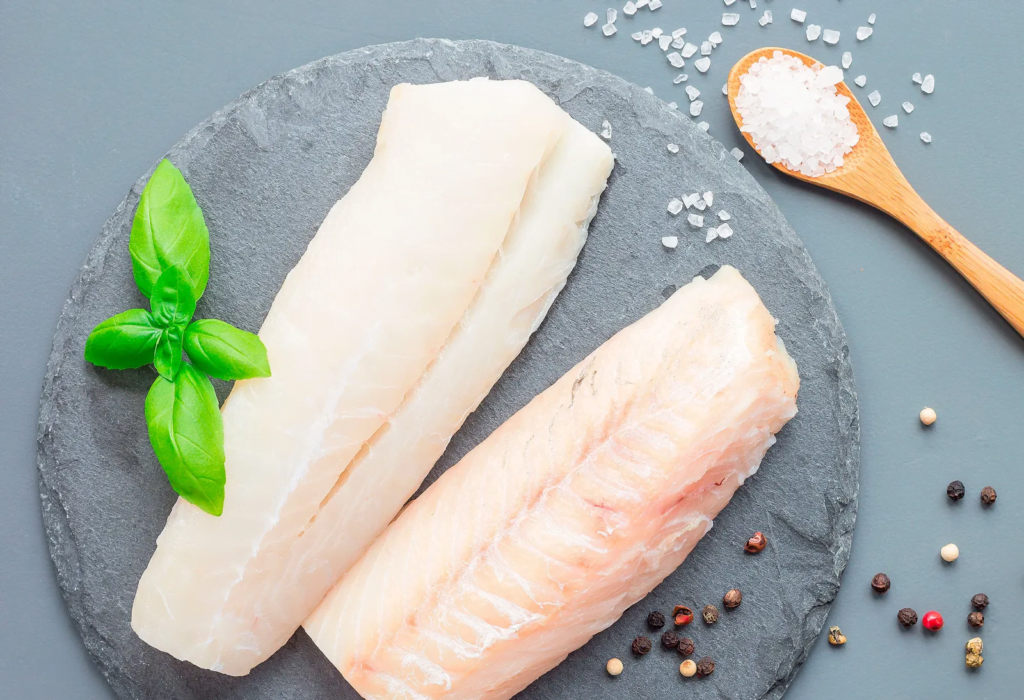
Background and History of Icelandic Cuisine – Saltfiskur
Saltfiskur, or salted cod, has a rich history in Icelandic cuisine. Over a millennium ago, Vikings traded not with gold coins or fur pelts, but with salted cod.
The preservation of cod with salt was essential, especially since refrigeration methods as we know them today were still a thousand years away. This method of preservation not only extended the shelf life of the fish but also imparted a unique flavor that many found delightful.
Icelandic Saltfiskur (Salted Cod) Ingredients
- Fresh cod fillets
- Salt (a generous amount)
Icelandic Saltfiskur (Salted Cod) Recipe
Salting the Cod
- Begin by laying out a tray and covering it with a layer of salt.
- Place the cod fillets on this salt bed.
- Generously cover the top of the cod with more salt.
- If it seems like there’s too much salt on the cod, it probably needs a little more.
Refrigeration
- Once the cod is thoroughly covered in salt, it should be refrigerated for a day.
Rinsing
- After a day, rinse the cod in cold water to remove the excess salt.
Wrapping and Storing
- Wrap the rinsed cod in muslin (or a similar cloth) and refrigerate it for a week.
- At this point, the salted cod can be stored and will keep for several weeks.
Cooking
- When you’re ready to enjoy the saltfiskur, it can be baked or pan-fried in butter.
- The result is a dish with a slightly crispy outer layer and a smooth, satiny texture on the inside.
- The flavor is salty but not overwhelmingly so, and the fish is rich in protein.
The salted cod can be enjoyed as is or used as an ingredient in various dishes. It’s a testament to the ingenuity of the Icelandic people, who found ways to preserve their food and make it delicious at the same time.
Icelandic Cuisine – Hangikjöt
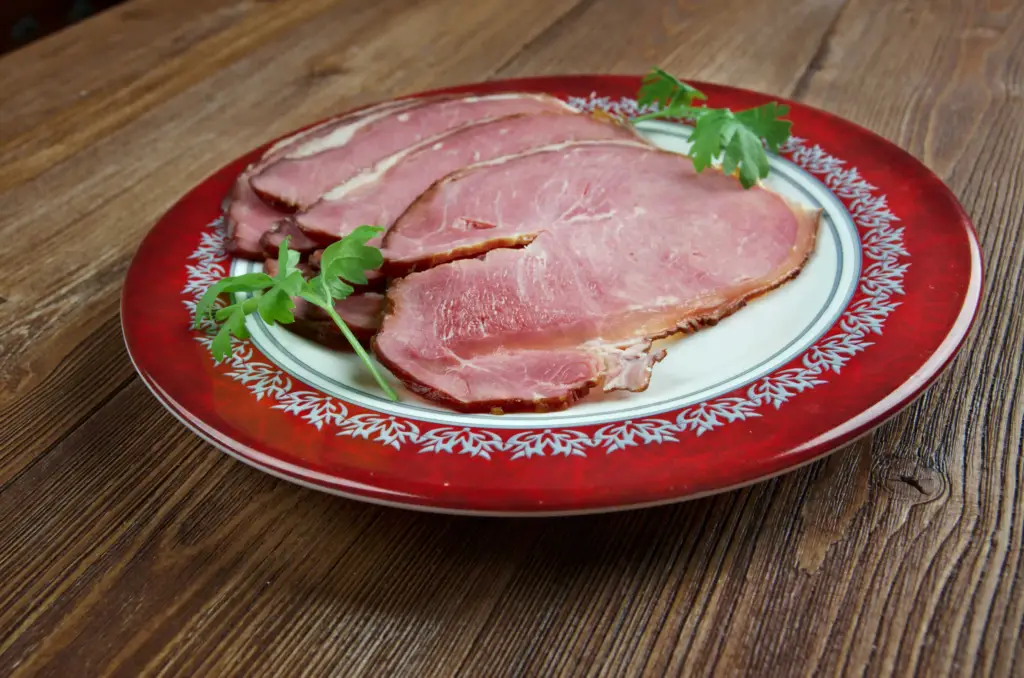
Background to Icelandic Cuisine – Hangikjöt
Hangikjöt, which translates to “hung meat,” is a traditional festive food in Iceland, particularly served during Christmas. It’s a smoked lamb or mutton dish that has been a part of Icelandic culinary heritage for centuries.
The name derives from the old method of smoking, where the meat was hung from the rafters of a smoking shed.
Hangikjöt – Icelandic Smoked Lamb Ingredients
- Fresh lamb or mutton (legs, thighs, or sides are well-suited)
- Coarse salt for pickling
- Birch, willow, juniper wood, or dried sheep dung mixed with straw (for smoking)
Hangikjöt – Icelandic Smoked Lamb Recipe
Salting the Meat
- Clean the meat thoroughly.
- Prepare a brine using water, coarse salt, sugar, and saltpeter (note: modern recipes might skip saltpeter due to health concerns).
- Submerge the meat in the brine and let it pickle for 2-4 days, depending on the thickness of the pieces.
Preparation for Smoking
- After pickling, allow the brine to drip off the meat.
Smoking Process
- Hang the meat in a smoking shed or a similar facility.
- The best smoke comes from wood, especially birch, willow, and juniper. Some Icelanders also use dried, pressed sheep dung mixed with straw.
- The aim is to achieve maximum smoke with minimal fire.
- The temperature of the smoke should not exceed 20-25°C. The meat should be smoked for 2-3 weeks.
Storing
- Once smoked, hang the meat in a cool, dry place.
- It can be stored for a long time and is more digestible after being hung for a while.
Serving
Hangikjöt can be eaten raw, thinly sliced, and wrapped around pieces of melon. For a traditional Icelandic Christmas meal, it’s boiled and served with potatoes, béchamel sauce, peas, and pickled red cabbage.
Leftovers can be thinly sliced and used as a topping for bread.
The process of smoking not only preserves the meat but also imparts a unique smoky flavor that’s deeply rooted in Icelandic tradition. Over the years, the method of preparation might have evolved, but the essence and cultural significance of Hangikjöt remain intact.
Icelandic Cuisine – Plokkfiskur

Background of Icelandic Cuisine – Plokkfiskur
Plokkfiskur is a traditional Icelandic dish that translates to “mashed fish.” It’s a hearty fish stew made by combining mashed fish, béchamel sauce, and potatoes.
This dish is especially popular during cold weather and offers a comforting and delicious taste of Icelandic cuisine.
Icelandic Cuisine – Plokkfiskur – Ingredients
- 1 lb gold potatoes, peeled and cubed
- ½ yellow onion, diced
- 10 oz cod, deboned and with no skin
- 3 tbsp unsalted butter
- 2 tbsp all-purpose flour
- ¾ – 1 cup milk
- ¼ tsp salt
- ½ tsp white pepper
Icelandic Cuisine – Plokkfiskur – Recipe
Cook the Potatoes
- Add the potatoes to a large pot and cover them with water.
- Bring the water to a boil and cook the potatoes until they are fork-tender (about 10-15 minutes).
- Drain the potatoes and return them to the pot.
- Mash the potatoes to your desired consistency.
Cook the Fish
- In a medium-sized pot, bring water to a boil.
- Add about 1 tbsp of salt to the water and reduce to a simmer.
- Add the cod and boil for 5-6 minutes until the fish turns white and flaky.
- Drain and set the fish aside.
Make the Béchamel Sauce
- In a Dutch oven, melt the butter over medium heat.
- Add the onion and sauté for about 5 minutes or until the onions turn translucent.
- Sprinkle the onions with flour and mix until a paste forms.
- Gradually add milk to form a wet paste consistency.
Combine
- Add the cooked fish to the Dutch oven and use a wooden spoon to mash it until it breaks into pieces.
- Add the mashed potatoes and mix well.
- If the mixture is too thick, you can add more milk to achieve your desired consistency.
- Season with salt and white pepper.
Serve
- Spoon the Plokkfiskur into bowls and enjoy with rye bread slathered in butter.
Expert Tips:
- It’s common to dice the potatoes into small pieces and add them to the Dutch oven instead of mashing them. This is based on personal preference.
- Cook the onions on low heat to soften them rather than crisping them up.
- Some variations of Plokkfiskur include additional mix-ins like bacon, tiny shrimp, black pepper, fish broth, curry powder, béarnaise sauce, sugar, and nutmeg. Some Icelanders also sprinkle cheese on top and bake the dish until the cheese melts.
Conclusion
In summary, we have explored the unique and delicious world of Icelandic cuisine. From traditional Icelandic dishes that have been passed down through generations to modern twists that blend traditional flavors with contemporary techniques, Icelandic cuisine offers an exciting culinary adventure for food lovers.
We have delved into the rich history and heritage behind traditional Icelandic food, showcasing the unique flavors and techniques that define this Nordic cuisine. We have also highlighted the delights of Icelandic seafood, renowned for its freshness and quality, and the flavorful Icelandic lamb dishes that offer a taste of the countryside.
In addition, we have discovered the unique ingredients that set Icelandic cuisine apart, from foraged herbs and berries to local dairy products, reflecting the country’s pristine environment.
Whether you’re a foodie or curious traveler, exploring Icelandic cuisine is a journey that will leave your taste buds wanting more. So what are you waiting for? Discover the diverse and delicious world of Icelandic cuisine today!
FAQ’s
What are some traditional Icelandic dishes?
Traditional Icelandic dishes include fermented shark (hákarl), dried fish (harðfiskur), and boiled sheep’s head (svið).
What makes Icelandic seafood special?
Icelandic seafood is freshness and of high quality due to the country’s cold and pristine waters. Some popular Icelandic seafood dishes include Icelandic cod (þorskur), salmon (lax), and pickled herring (síld).
What are the Unique Flavors Of Iceland?
The unique flavors of Iceland offer a diverse culinary experience. From traditional dishes like hákarl (fermented shark) to skyr (Icelandic yogurt), the country boasts a range of distinctive tastes.
Visitors can also savor the local seafood, including luscious langoustines and richly flavored Arctic char. Iceland’s cuisine is a treat for adventurous foodies.
What are some unique ingredients used in Icelandic cuisine?
Icelandic cuisine incorporates unique ingredients such as foraged herbs and berries, local dairy products (including skyr, a traditional Icelandic yogurt), and Icelandic sea salt.
How do modern chefs in Iceland innovate with traditional dishes?
Modern chefs in Iceland put innovative twists on traditional dishes by incorporating new cooking techniques, experimenting with flavors, and incorporating international influences while still honoring the traditional flavors and ingredients.
Where can I try Icelandic cuisine?
You can try Icelandic cuisine at local restaurants in Iceland, as well as at Icelandic food festivals and events that celebrate the country’s culinary traditions.
This Article was lasted edited on

